
94% of researchers rate our articles as excellent or good
Learn more about the work of our research integrity team to safeguard the quality of each article we publish.
Find out more
ORIGINAL RESEARCH article
Front. Commun. , 27 June 2022
Sec. Psychology of Language
Volume 7 - 2022 | https://doi.org/10.3389/fcomm.2022.781320
This article is part of the Research Topic Englishes in a Globalized World: Exploring Contact Effects on Other Languages View all 17 articles
The objective of this chapter is to apply a synthesis of models for world Englishes to Irish English, for which data from ICE-corpora, the Handbook of Varieties of English, the Mouton Atlas, eWAVE, and the GloWbE corpus are used, and to which many approaches are applied: geo-political, dynamic-model, corpus, statistical, and multi-functional factor analysis. The chapter's relevance lies in its bringing together wide-ranging and seemingly disparate material through the lens of Irish English as a common denominator. The chapter shows the difficulties of applying top-down models to empirical corpus data and concurs that the gap is ultimately unbridgeable. Nevertheless, in so far as status distinctions can be inferred, this chapter also concurs with the many different findings that, as a standardized variety, despite a historical legacy of contact, Irish English is indeed an L1.
This chapter will explore the relationship between Irish English and world English(es). It will cover many approaches and raise many issues. It will show the need for the notion of “Irish English” to be recurrently clarified—especially the distinction between the vernacular variety and the standardized variety; and it will acknowledge the importance of a critical awareness between the two. The chapter is also mindful that, because of the presence of both Hiberno-English features as well as features from Scots, as shown in standardized data, the wider reality of educated public discourse in Ireland is never fully standardized.
Three research questions arise in this chapter: How has Irish English been characterized as an English among world Englishes given the range of approaches used in different investigations? What status does Irish English have as a world English as a result of the particular approach used? What overall conclusion about the status of Irish English as a world English may be drawn?
Several possibilities regarding status within Ireland and between Ireland and Great Britain have been proposed. This chapter will consider the status which has been accredited to Irish English in those top-down models of varieties of English around the world, especially those by McArthur (1987); Görlach (1990); Mesthrie and Bhatt (2008); Mair (2013); Siemund (2013), and Onysko (2016), among a few others on the one hand, and on the other by the quite different approach taken by Schneider (2007). Schneider (2007) Dynamic Model will then receive a short summary of an interpretation by Ronan (2020). The general challenge for all models of world Englishes is their demonstration and vindication of hypotheses on the basis of empirical corpus data. The few attempts that have been undertaken are reviewed by Hundt (2020), whose findings will be presented and whose conclusion that the gap would appear unbridgeable will be acknowledged.
The chapter will go on to recognize that there is no shortage of both standardized as well as non-standardized data (resources ICE, eWAVE, GloWbE, and so on, to be discussed below) for comparison and statistical evaluation. A further section will use the GloWbE Corpus to deal with the status of lexical items originating in Ireland, some of which will be shown to have remained there as Irishisms, whereas others have spread their wings and are now to be found in almost every variety around the world.
These global comparisons of individual items will lead into the final part of the chapter, which is concerned with various statistical attempts to assess and relate Irish English data to a great range of varieties worldwide, including pidgins and creoles. Whether ICE-corpora are used for data or the list of observation data behind eWAVE, whether multi-dimensional factor analysis is used on the standardized data, or whether multiple correspondence analysis is used on the reported observations of Hiberno-English data, the chapter will show that Irish English becomes repeatedly vindicated as an L1 or (in the Schneider, 2007 model) a stage-5 differentiated, variety, tout court, in answer to the third research question.
To these ends, such a synthesis arises from a combination of the relevant research literature that has so far been published as well as a fresh application of some of these approaches to Irish English data. The approach taken in this chapter is also informed by the author's knowledge and experience both as a resident in Northern Ireland since 1983, as a dialectologist of Irish English, and as a corpus linguist, particularly of Irish English and increasingly of world Englishes.
This first section deals with how Irish English has been conceived within the various frameworks for the study of world Englishes which have been proposed. It was during the 1990s and early 2000s that there emerged a new paradigm for conceptualizing the status of national varieties of English: that of World Englishes.1 The investigation of this paradigm was facilitated by the growing provision of national components of English for the International Corpus of English (ICE) corpus (cf. Greenbaum, 1996), particularly those of L2 varieties, where English was becoming shaped by mother tongue speakers absorbing features of indigenous languages and where speakers of those languages were gradually acquiring English, by immersion, bringing many of their own mother-tongue features with them, or by instruction, usually in a predefined norm of standardized English. A central question which arose during a review of the ICE project (Kirk and Nelson, 2018) was how far the models used for the delineation of world Englishes were adequate to deal with such multilingual environments, or whether they were becoming outmoded—such as for instance, the Quirkian notion of a “monochrome international standard language” with only local deviations (Quirk et al., 1985, p. 6).
Languages and their related offspring have traditionally been conceived of as trees, so when that tradition is superimposed on a map of the world, as Strevens (1980) did, it shows two main roots of British English and American English from which all other branches are deemed to stem.
Not surprisingly, as Figure 1 shows, the line to Ireland is the shortest. The lines are drawn on a geo-political basis and identify countries around the world where English (of some sort) is to be found. The schema simply denotes Irish English as a descendant of British English.
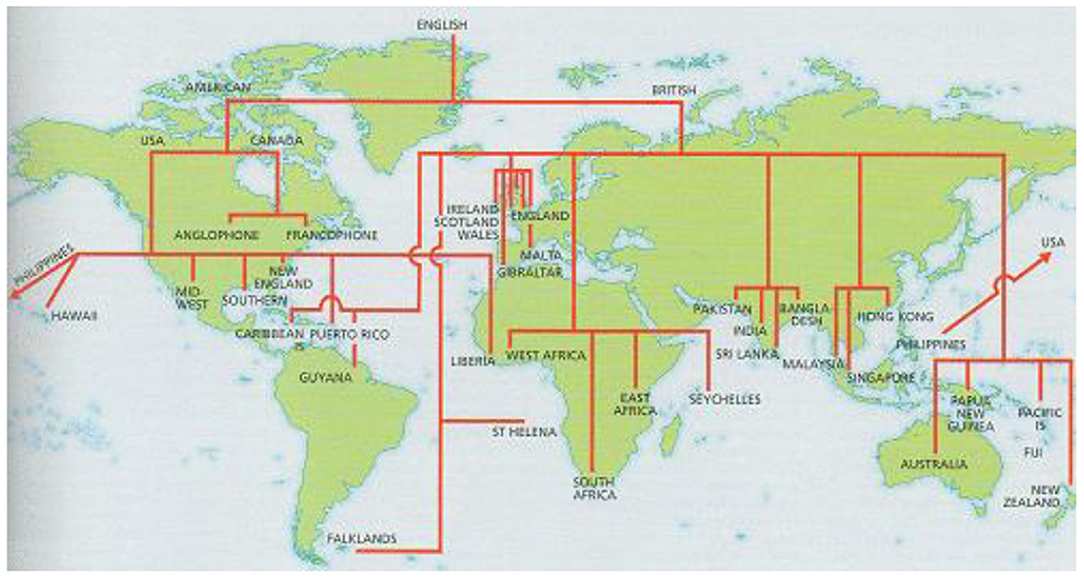
Figure 1. Strevens's Geo-political Map of world Englishes (from Crystal, 1995, p. 107, redrawn from Strevens, 1980).
Another image for describing languages is that of the wheel—of the hub and the rim, with the spokes in between.
In Figures 2, 3, the hub is shown to be the part which is invariant and which holds all the other parts together—labeled as “World Standard English” by McArthur (1987) and “International English” by Görlach (1990), each not unreminiscent of Quirk's “monochrome international standard”. Indeed Mesthrie and Bhatt (2008) comment that McArthur's “World Standard English” is “obviously an idealization” (p. 27), perhaps best represented as “written international English”. For McArthur, “World Standard English” is a hub surrounded by a set of spokes, each labeled for a geographical area—with separate spokes for “British English” and “Irish English”. The space in between is labeled as “British and Irish Standard English”, as if a single entity. This view would appear to perpetuate the then prevailing view of Irish English as simply a matter of extra-territorial expansion, under exonormative (i.e., British) control.
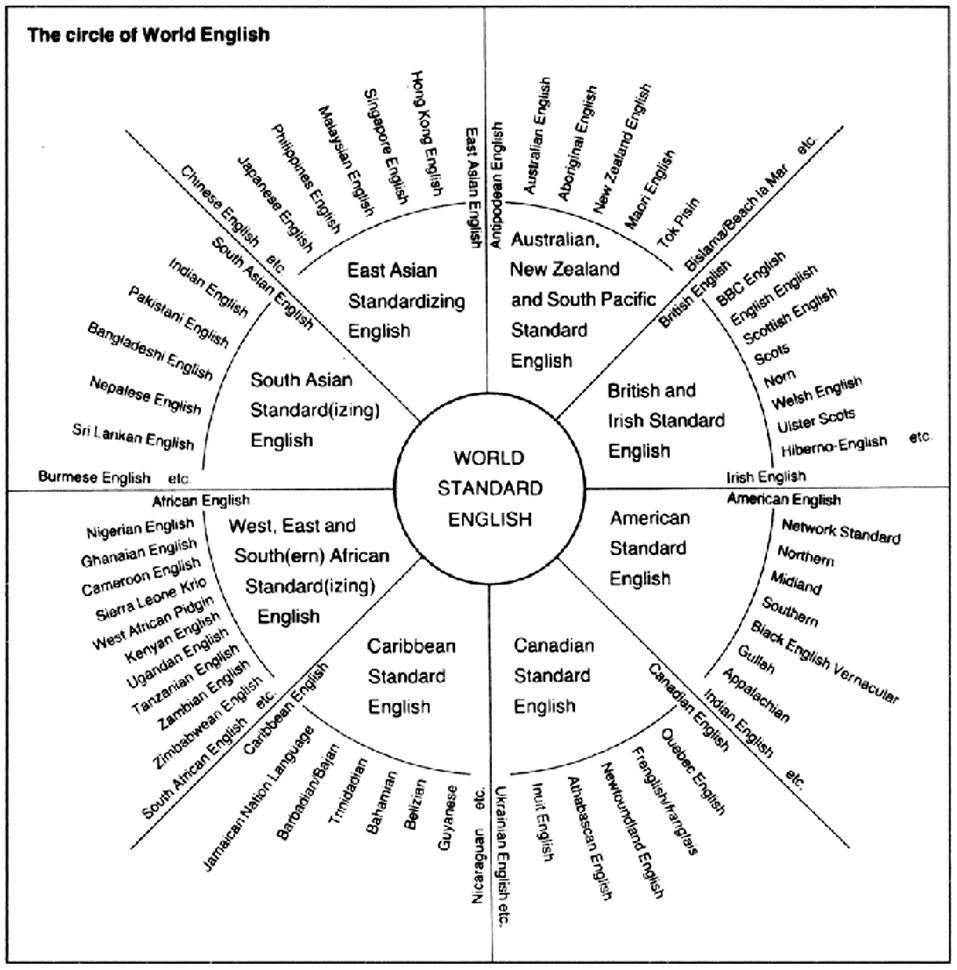
Figure 2. McArthur's “The Circle of world English” (from McArthur, 1987, p. 11).
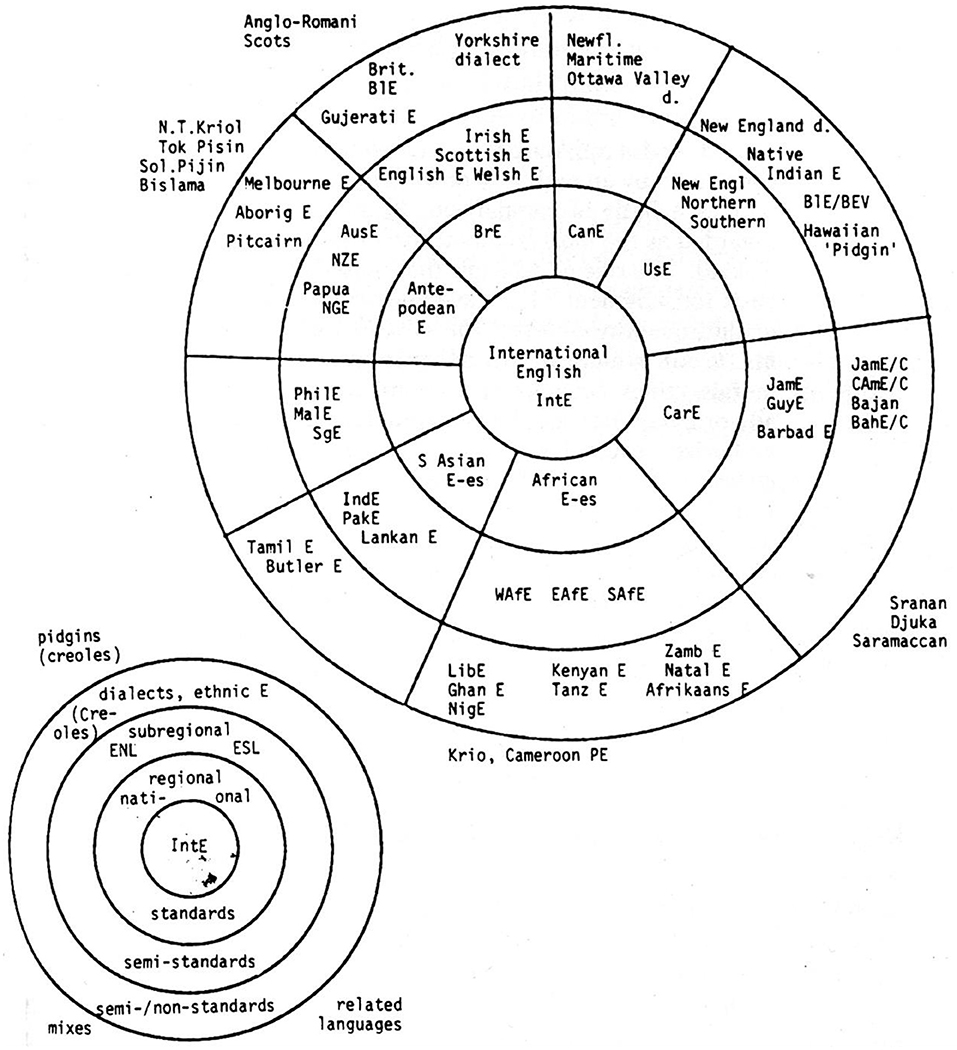
Figure 3. Görlach's “Circle of International English” (from Görlach, 1990).
In Görlach (1990) circle, the spokes are not labeled but, as the concentric circles radiate out from the hub, the set of spaces in the first circle are labeled as “regional national standards”, the second as “sub-regional semi-standards”, and the third and outermost circle labeled as “dialects”, “ethnic semi-standards” or “non-standards”. Thus it is as a “regional national standard” that British English is labeled, and Irish English as a mere “sub-regional semi-standard”, albeit in the company of Scottish English, Welsh English and even English English. Elsewhere, Görlach (1995) laments that many words of Irish English do not appear in standard reference dictionaries and may not be known to people even with a good knowledge of English. Görlach (1995) challenge is addressed by Kirk and Kallen (2011) by looking at the vocabulary contained in ICE-Ireland (Kallen and Kirk, 2008). They show that there are many cultural references which are well known in each part of Ireland, of which people have clear awareness in their heads, which are used widely in broadcast media, but which are neither shared with the other part of Ireland nor with anywhere else. Examples include decommission(ing), peace process/dividend, and maracycle (cf. Kirk and Kallen, 2011). Such terms involve familiar, everyday words used in specialized senses or with a meaning somehow altered and thereby expressive of a particular cultural value. None of these words or expressions belongs to traditional dialect, and only some to the Irish language. Rather, Kirk and Kallen develop a cultural hypothesis which came to be substantiated by local semantic extensions or refunctionalisations in English, from the result of which emerges a cultural vocabulary which is finely-hewn for each polity, Northern Ireland and the Republic of Ireland. Nevertheless, this vocabulary remains still relatively unfathomable to outsiders, so that a glossary for ICE-Ireland would not go amiss.
Shortly before the McArthur (1987) and Görlach (1990) models were published, a set of very different circles was proposed by Kachru (1982), as shown in Figure 4A.
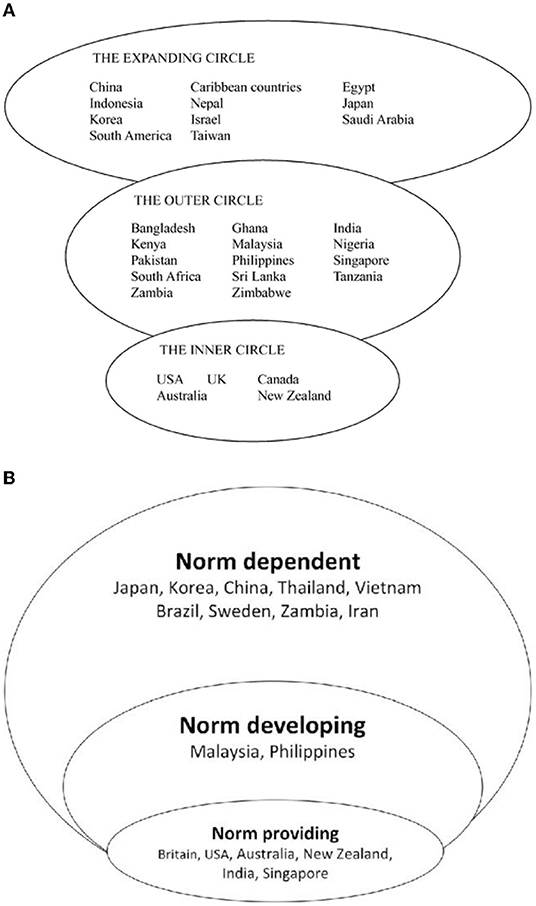
Figure 4. (A) Kachru's “Three Circle of English” model (adapted from Kachru, 1982). (B) Kachru's “Three Circle of English” model (adapted from Haswell, 2013)4.
Kachru extends Strevens's geo-political varieties to combine national varieties into groups depending on the status of English there: as a national language (ENL) or mother tongue (EMT), as an official additional or second language (ESL or EAL), or as a foreign language (EFL). These groupings comprise three non-overlapping circles respectively: an inner circle, an outer circle, and an expanding circle, which have been drawn by others in various ways. The outer circle comprises countries to which English had been taken during period of colonization such as India, Kenya, or Singapore. The expanding circle comprises countries where English has had no internal or institutional status such as most countries in Europe but also countries such as China or Brazil. To each of the three circles Kachru (1982) added a further designation: ENL-countries were “norm-providing”, ESL countries were “norm-taking”, and EFL countries were “norm-dependent”, as shown in Figure 4B.
Although Kachru's model was concerned with postcolonial Englishes of relatively recent times, it was not supposed to be concerned with “old” colonies such as Ireland. Thus, after centuries of English use, Irish English was placed in the norm-providing, native/mother tongue category. That Irish English qualifies as a norm-provider may be adduced from its diasporic effects—in Newfoundland, in American English, and in emigration to the urban areas in Great Britain such as Glasgow, Liverpool or London. Although Kachru (1982) model has been much discussed and become hugely influential, as the present focus is on Irish English, many of the specific criticisms need not concern us here. However, Kachru (1982) model has recently been vindicated by Axel Bohmann (2020) in a multi-dimensional factor analysis of some 10 ICE-corpora, as discussed below.
Kachru's model shifted the focus away from nation states to different categories of speakers and users of the language, including learners. For Modiano (1999), for instance, among learners it's as much a question of proficiency in the language as it is with native speakers.
Although Ireland doesn't figure explicitly in Modiano's model (see Figure 5), the distinction around language functionality which he makes can be plausibly conferred on the Irish situation: between the low registers in the vernacular (often referred to as Hiberno-English) and confined to Ireland, and standardized English, acquired largely through education and exposure to situational need, which takes care of the higher registers and international communication.
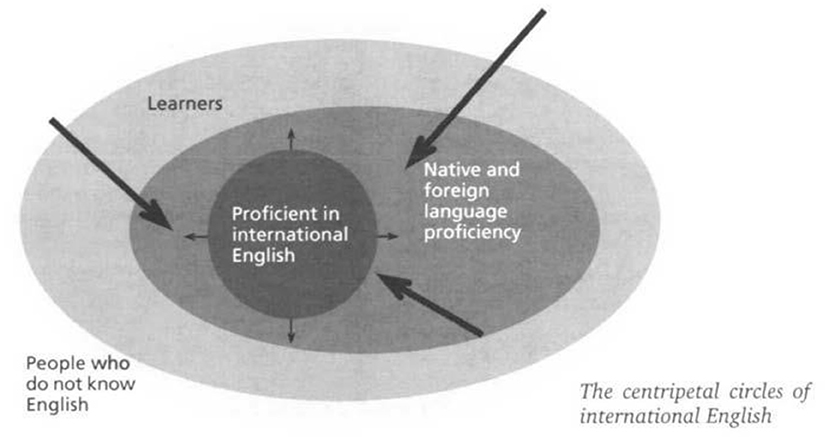
Figure 5. Modiano's “Centripetal Circles of International English” (from Modiano, 1999, p. 25).
Reconceptualisation was taken further by Mesthrie and Bhatt (2008) in what they came to call “the English Language Complex”, with no fewer than 12 subtypes.2 Of those, they claim that Hiberno-English, once a “language-shift variety”,3 i.e. a variety which “has at some crucial stage of its development involved adult and child L1 and second-language (L2) speakers [as] one speech community […] with L1 and L2 speakers of the dialect closely interacting with each other” (p. 6), is now “probably best classified as a social dialect” (p. 6) bound up in a community with only L1 speakers. Nevertheless, despite its comparability with other L1 dialects within Britain, and its role in turn as a superstrate variety in certain later colonial situations, Mesthrie and Bhatt (2008) revert to its origins as “a language shift variety” citing Hickey's observation that “the majority of the Irish acquired English in an unguided manner as adults” (p. 44). Without this significant contact with L1 speakers, Mesthrie and Bhatt (2008) claim that Irish English as an L2 came to result in and stabilize as an L1, and thus, because of its linguistic features similar to other colonial Englishes, Irish English is, in effect, a “new English” or a quasi-outer circle variety. This rather inductive view would seem be somewhat out of keeping with more empirical claims and findings discussed below.
A further model (Figure 6) along geo-political lines is the “World System of Englishes”, put forward by Mair (2013), wherein circles are replaced by a hierarchical list, with a hub at the top of this list, from which all other levels thence descend. Irish English is ranked as a “central variety”, perched along with (explicitly) “Scottish Standard English” between super-central varieties” (British English) and “peripheral varieties”. An innovation in Mair's model is the inclusion and linking at each level of a separate hierarchy of non-standard varieties, ranging from the same set of levels. In terms of this model, if Irish standard(ised) English ranks as “central”, Hiberno-English ranks merely as “peripheral”.
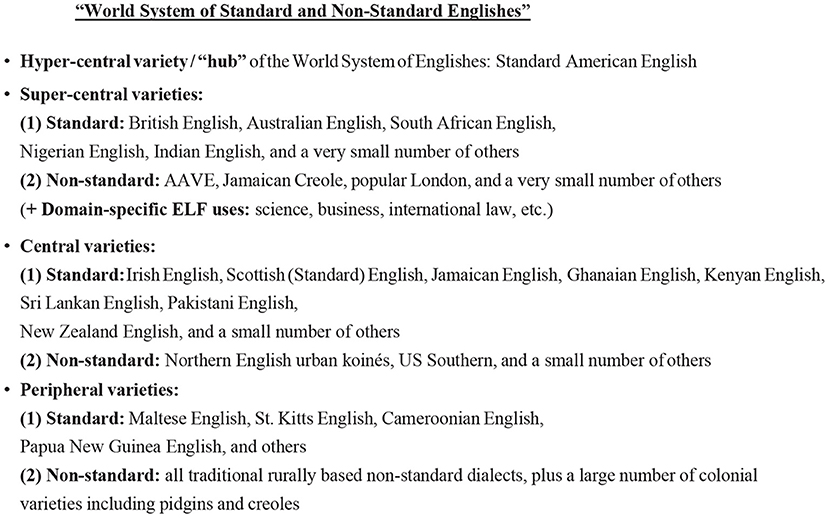
Figure 6. Mair's “World System of Standard and Non-Standard Englishes” (from Mair, 2013, p. 264).
The World System of Englishes entails a cascading-down approach: super-central varieties will influence central varieties but not vice versa—thus British English on Irish English but not vice versa. As Mair comments: “there will be more British terms spreading into Irish usage than in the other direction.” (Mair, 2013, p. 262). It is doubtful that Irish English will cascade-down to influence “peripheral varieties”, unless perhaps, because of nineteenth-century emigration, on urban varieties in England such as Liverpool or Newcastle-upon-Tyne. But yet again, it depends on what is being meant by Irish English: simply vernacular Hiberno-English, whether northern or southern? And moreover what is meant by influence, or who the influencer is.
A more recent top-down classificatory model—the “Language Contact Typology of world Englishes”, by Onysko (2016) reproduced in Figure 7—is based on the premise that all variation arises from contact. Here, the early foundation of English in Ireland may be classified as an “English in multilingual constellation”.
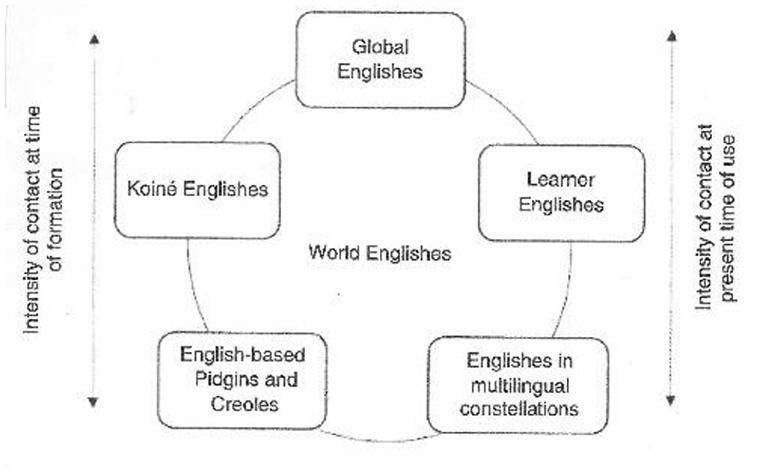
Figure 7. Onysko's “Language Contact Typology of world Englishes” (from Onysko, 2016, p. 213).
In his model, Onysko (2016) applies Van Coetsem (1988, 2000) distinctions between a “source language” (in this case Irish) and a “recipient language” (in this case English). Onysko's claim is that, if the source language is dominant in the contact situation, its impact on the recipient language will go beyond basic lexical influence (assumed to be borrowing) and be significant. In this contact situation, speakers of the recipient language (English) will thereby feel pressure to acquire the source language (Irish) and adopt many of its features from different levels. The corollary claim is that, if the recipient language (English) is dominant in the contact situation, it will remain dominant and absorb only lexical features from Irish. Thus, Onysko contends, it was this essentially parallelism in the bi-lingual contact situation which laid the foundations for what eventually led to the wholesale language shift from Irish to an Irish form of English, stretching from the late 18th to the early 20th centuries. From the view of the contact model (Figure 7), the emergence and early foundation of Irish English fits the general scenario of “Englishes in multilingual constellations” whereby continuing source language agentivity turned into a scenario of large scale language shift.5
Either way, many Irish words found their way into Irish English. Although these words are considered as “loanword borrowings”, Kallen (1996) has urged that they are probably better understood as “apports”. For Kallen, apports are “Irish words retained in the English language after a community switch away from Irish” (Kallen, 1996, p. 109, cf. also Kirk, in press). The notion suggests the source-language activity of ““survival” and the “carrying over” of elements in the Irish lexicon [which speakers of Irish felt they couldn't give up]—rather than borrowing by English [and it] suits much of the development of Irish English, especially during the major period of language shift” (Kallen, 2013, p. 132).
After the completion of the shift for large parts of the population, Irish English can be considered as developing further—largely as a “Koiné English” (i.e., as a result of dialect contact between the emerging variety of Irishised English and other varieties of English).
More recently, a further contact development was to develop: spoken vernacular English in Ireland has come to find itself in contact with other dialects and varieties of English, most notably the standardized variety, but also British regional varieties, reinforcing further the classification of Irish English as a “koiné”. Koiné features from dialectal English are certainly shown to be present in southern Hiberno-English by Klemola (1994, 2002) and Anderwald (2002), and those from Scots in northern Hiberno-English (Kirk and Kallen, 2010)—all further evidence of source-dialect activity and of apporting rather than borrowing. Most recently, Irish English is facing a new Koiné -contact situation. whereby it is Irish English that is being acquired as their English by communities of migrants, most predominantly from Poland. Thus in time, Irish English stands to become subjected to modification though their learning efforts (cf. e.g., Migge, 2012; Nestor et al., 2012; Diskin and Levey, 2019; Corrigan, 2020)—a further instance of emerging bilingualism in a multilingual constellation, with Irish English as the target L2 language for L1 speakers of Polish.
Against these top-down, geo-political approaches at explaining the relationships between world Englishes, there has arisen an alternative paradigm with an altogether different approach. This is the “Dynamic Model”, advanced by Edgar Schneider, initially in an article (Schneider, 2003), later in more detail in a monograph (Schneider, 2007). The focus of this model is on the English of former (mostly British) colonies, and is “dynamic” because it sets out explanations for the evolution and development of the Englishes in these countries. There is a basic premise whereby Englishes developed through an evolutionary process which is uniform, and which can be accounted for in separable stages. In such counties, two groups of speakers are always identifiable: firstly, the settlers (in the case of Ireland, English in the South; English and Scots in the North) who brought their mother tongue with them and who, over time, come to acquire features taken over from local languages native to the place; and, secondly, the indigenous, colonized people—the Irish—who begin to acquire the language of their new colonial masters. Initially, for the early phases, the English is based on that of the settlers and follows their (largely British) “norm-providing” or “exonormative” patterns (Schneider's second tier). Over time, and inter-generational transfer and inter-marriage, and in Ireland advanced by language shift, the English of each group comes to merge, with features becoming transferred from Irish and now shared in common and thus nativized (Schneider's third tier) (similar to Mesthrie and Bhatt's “language-shift” variety above). Over further time and deeper integration, features come to have local characteristics of their own or “endonormative” patterns (Schneider's fourth tier). Finally, there is full linguistic independence or “differentiation” (Schneider's fifth and final tier) or independent variety.6
So what of English in Ireland, Britain's oldest colony? A trenchant case for the development of English in Ireland in line with the Dynamic Model is made by Ronan (2020). Ronan recognizes that the model's foundation stage is not met—English arrived on the back of Anglo-Norman French, the speakers of which were the colonizers and in due course the power-holders, so that, for much of the later Middle Ages, the prestige languages of Ireland were French, Irish, and Latin. As Hickey (2007) and Ronan (2020) comment, English didn't really take off in Ireland until the Plantations of the North in the early 17th century and in the South later that century—what amounted to a second colonization. Large numbers of Gaelic population groups began then to shift to English. For Ronan, “it is in […] examples of seventeenth-century Irish English that we find examples of exonormatively standardized English on the one hand, and on the other hand heavily contact-marked varieties […] which could be seen as typical markers of ongoing nativisation of the English language in Ireland.” (p. 336) As time went on, Ronan argues, “a situation of diglossia started to emerge, in which English was increasingly used in all domains while Irish was relegated to daily life particularly in rural areas.” (p. 338) Here, Ronan contends, “we can speak of a second nativisation process of the English language”. She elaborates: “English made further inroads when a National School system was introduced in 1831, and the death blow was dealt to [Irish] by the depopulation of rural areas during the famine years in the 1840s (p. 338). Over time, the widespread Irish monolingualism turned into bilingualism and was replaced by English monolingualism. The growing importance of English, especially in the economy and in politics, led to a steady decrease of Irish speakers in all areas of the country. “Arguably”, Ronan continues, “it is this spread of English as the first language of the education system and the increasing loss of the Irish contact language which caused the endonormative stabilization of the language” (p. 338), including the incorporation of many well-known features of Irish as discussed above which had become transferred.7
Schneider's final stage of differentiation is equated by Ronan with regional dialect differences (northern vs. southern, as mentioned above) and social differences which are ongoing (as, for instance, with the Dublin accent, and its supra-regional influences further afield; cf. Hickey, 2005). A further case for differentiation must surely be the distinctiveness of the vocabulary and its extensive codification in recent dictionaries: A Dictionary of Hiberno-English (Dolan, 2014), Slanguage, (Share, 2014), and the Concise Ulster Dictionary (Macafee, 1996) (cf. also Kirk, in press).
Schneider's model has been well-received, with some debate about the stage of development to which a variety is allocated, and about whether some nativised varieties have developed their own norms. Recent vindication comes the multi-dimensional factor analysis in Bohmann (2020), as discussed below.
Meanwhile, the Dynamic Model's applicability to non-colonial countries has been tested in investigations of European and Asian countries, with positive results, although, inevitably, the first two stages cannot apply. In such countries, where English has no settler population or institutional status, it has been acquired entirely through education with an inevitable focus on the standardized language (Edwards, 2016, p. 190).
Thus, to accommodate developments in common, there has arisen the notion of what Schneider (2014) calls “transnational attraction”, a further dynamic concept intended to explain the influence of English on languages everywhere, no matter their status. Behind this notion lie notions of globalization, of instantaneous electronic-mediated communication, widespread global travel, affluence in westernized societies and, increasingly, migration into large urban centers of multi-ethnicity or what's become labeled as super-diversity, such as Singapore, Hong Kong and Dubai (cf. Siemund and Leimgruber, 2021). Of such social influences, Irish English has certainly not been exempt, with many multi-national companies such as Apple, Google and Microsoft setting up production facilities in Ireland, or the influx of particularly eastern and southern Europeans to Ireland.
To sum up this synthesis of proposals for conceptualizing the status of national varieties, we have thus seen that Irish English has been categorized internal-linguistically as: “standard” (McArthur, 1987), “sub-regional semi-standard” (Görlach, 1990), “inner circle”/“ENL”/“EMT” (Kachru, 1982), “contact”, “central” (Mair, 2013), “koiné” (Oynsko, 2016) and “differentiated” (Schneider, 2007); also externally as “postcolonial” (Schneider) and “new” (Mesthrie and Bhatt, 2008). Can they all be credible? The differences of focus in Ireland have inevitably split between high and low prestige languages in an earlier period (as well documented in Kallen, 2013, p. chs. 1 and 5; Kallen, 2017) and, in the modern period, between vernacular Hiberno-English and the standardized variety. Although features of the vernacular occur in the standardized variety only in small measures, the latter is no less Irish in their indexicality. The two extremes remain joined through the abiding distinctiveness of the vocabulary.
Top-down conceptualization has not been the only approach to considering Irish English within world Englishes. For there has been a further development of a further paradigm. With the growing availability of ICE-corpora, Irish English has come to feature as a national “dialect” in inter-corpus comparisons. A great many studies have compared the data of ICE-Ireland with the data of other ICE-corpora. The recent textbook by Lange and Leuckert (2020) encourages inter-ICE-corpora comparisons with a set of five exercises (on phrasal verbs, the definite article, embedded questions, processes of compounding and suffixation, and adverbial intensifiers). Such studies are facilitated by the ICEonline software which at a stroke can compare up to 15 national components. A recent article by Hundt (2020) reviews the research which uses ICE-data to substantiate the claims of various WE models as outlined here. Section §22.4.1 of Hundt (2020) is entitled “Corpora as a Testing Bed for Models of world Englishes”–specifically Kachru's Three Circles Model, Schneider's Dynamic Model, and the Epicenter Hypothesis.8 With respect to the Three Circles Model, Hundt comments: “numerical evidence on individual grammatical patterns does not necessarily support the distinction between ENL, ESL, and EFL varieties …” (Hundt, 2020, p. 515) and provides examples of those which do and those which do not.
For testing Schneider's Dynamic Model of the evolution of WEs for different degrees of nativisation, Schneider himself urges that “ the most promising road to a possible detection of early traces of distinctive features is a principled comparison of performance data collected along similar lines, i.e. systematically elicited corpora” (Schneider, 2004, p. 227). To this end, the verbal complementation patterns intransitive, monotransitive, or ditransitive, and their lexical exponence are investigated in ICE-India, ICE-Hong Kong, ICE-Singapore along with ICE-GB in a range of articles by Mukherjee and Gries (2009) and Gries and Mukherjee (2010). Hundt reports favorably: “[…] Mukherjee and Gries (2009)” collostruction analysis reveals that a variety's divergence from BrE tallies well with its respective developmental stage […]” (Hundt, 2020, p. 516), so that if ICE-Ireland data were used, and with stage 5 differentiation, close or comparable similarity with ICE-GB data would be likely. Using the same corpora, however, in an investigation of n-grams and their bundling, Hundt reports further: “Gries and Mukherjee (2010) study of lexical bundles did not provide additional evidence that the more advanced a variety is in the evolutionary cycle, the more it will have developed region-specific usage patterns” (Hundt, 2020, p. 516). Whereas these findings may hold for the Asian varieties which were investigated, there are two implications for Irish English: firstly, if applied to ICE-Ireland, distinctive patterns of lexical exponence in complement types may not be found either as the corpus is far too small for such purposes.9 That notwithstanding, as differentiation in Schneider's model entails lexical distinctiveness, we know that such distinctiveness exists from the recent lexicographical records, as discussed above. From Hundt's comprehensive article, it would be fair to infer that there must be extremely few research publications which have used (or, moreover, can use) corpus data directly to substantiate the claims or implications of top-down, largely geo-political models of world Englishes. The inference gap appears to be simply unbridgeable—or at least so far.
In what other ways is it possible to relate and compare Irish English to other varieties of English. One is to use the Electronic World Atlas of Varieties of English (eWAVE),10 compiled by Bernd Kortmann (see Figure 8). Here, information on maps and in lists for some 225 features in 77 countries is presented. It is a database, not any kind of corpus. The list of features was drawn up in the early 2000s by Kortmann on the basis of what was then known about non-standard features in varieties of English world-wide and collated into an organized list. A list of areas was compiled where coverage might be revealing and the inclusion of which was considered important. The upshot of all these data is that Irish English (covered by Markku Filppula) is categorized as a “high-contact L1 variety”.
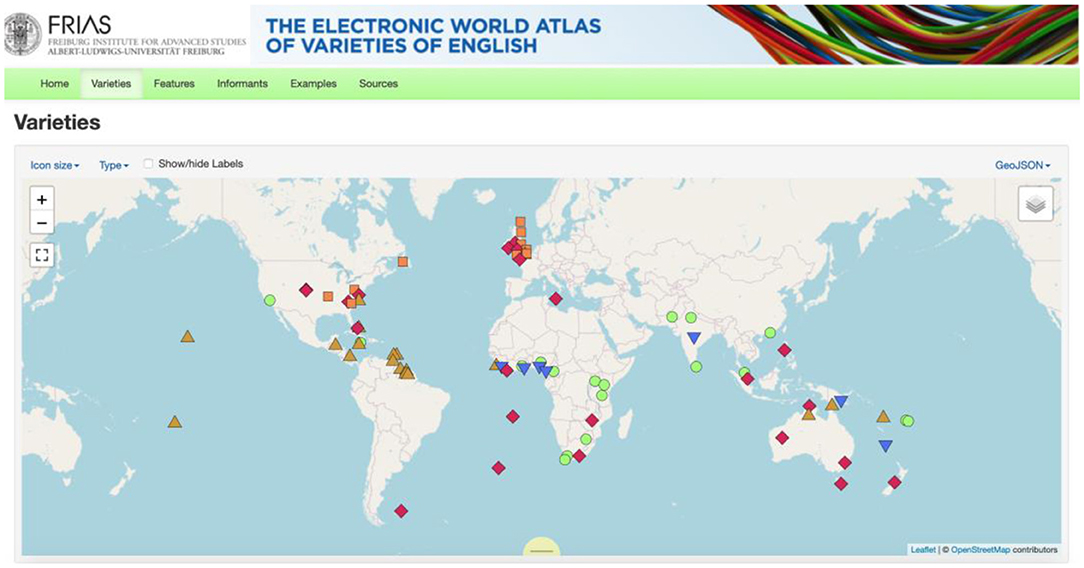
Figure 8. eWAVE Atlas (from https://ewave-atlas.org/languages).
Of the 23 features given an A-rating (“feature is pervasive or obligatory”) for Irish English in eWAVE, the rarest occur in only one other variety: the after-Perfect (feature 98) in Newfoundland, and the unsplit for to in infinitival purpose clauses (feature 202) in Tristan da Cunha; two other features occur in only three other varieties: the absolute use of reflexives (feature 15) in Manx English, Saramaccan English and Eastern Maroon Creole, and forms or phrases for the second person singular pronoun other than you (feature 35) in Orkney and Shetland English, Gullah, and Saramaccan English. A further feature occurs in only four other varieties: the use of definite article where StE favors zero (feature 64) in Manx English, Indian English, Hong Kong English, basilectal Fiji English. For the far-flung distribution of some of these features, there is probably no single explanation. But in view of their rarity, it would not be inappropriate to consider them Irishisms (and the after-perfect usually is!). On the other hand, some of these “pervasive and obligatory” features are quite widely distributed: in some 60 (out the total of 77) countries, alternatives for the second person plural you pronoun (feature 34; see Figure 9) are listed for 63 countries, and the lack of inversion and elision of the auxiliary in questions (feature 229; see Figure 10) is attested in 67 countries.
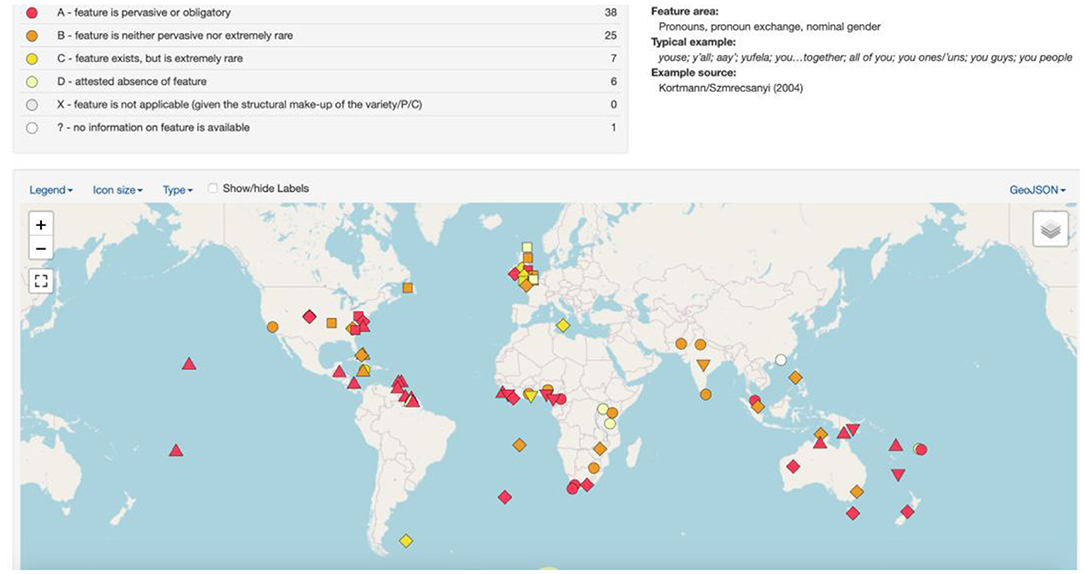
Figure 9. Screenshot of eWAVE Feature 34: “Forms or phrases for the second person plural pronoun other than you” *from https://ewave-atlas.org/parameters/34#2/7.0/7.7.
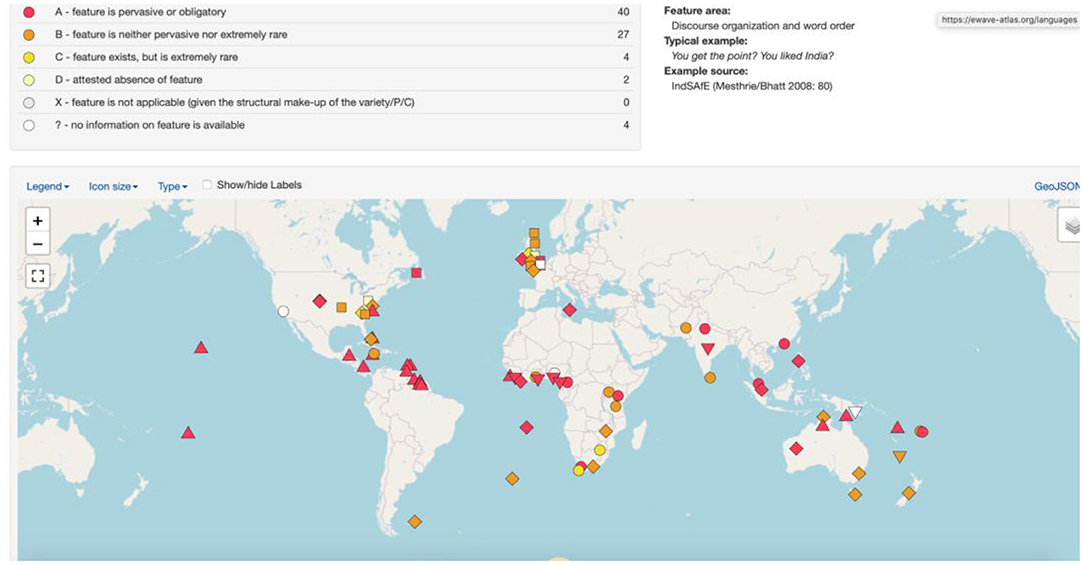
Figure 10. Screenshot of eWAVE Feature 229 “No inversion/no auxiliaries in main clause yes/no questions” (from https://ewave-atlas.org/parameters/229#2/7.0/7.7).
The eWAVE maps are thus able to show at a glance how widespread a feature of Irish English actually is—with maps that not only show the A-D ratings11 of the response but also the categorization of the variety (as an L1, L2 or creole type).
The online atlas derives from the earlier Mouton World Atlas of Variation in English (Kortmann and Lunkenheimer, 2013), where slightly different results are to be found. For Irish English, the after-perfect is the only A-rated feature. However, there are listed some 16 B-rated features (p. 695). In the Mouton Atlas, Irish English is again categorized as a “high-contact L1 variety”, one of five broad classes of variety types.12 The Mouton Atlas presents various groupings such as the most frequent features across 28 of the 30 L1 varieties surveyed (p. 681–682). Whereas Irish speakers of English are aware of features they have and which seem to depart from the codified standard—and have responded well to acceptability judgements13—these speakers simply do not know how widespread within Ireland or how localized to Ireland any feature actually is. Without comparison, “it is not possible to establish any variety-exclusive and variety-preferential features of any (regional, socio-economic, ethnic, etc.) dialect”, according to Barron and Schneider (2008, p. 429). It is not only to qualitative and quantitative comparisons of this kind that the Mouton Atlas lends itself but also to multi-factorial and typological analyses. For individual morpho-syntactic and discourse-pragmatic features, the Mouton Atlas and eWAVE stem from a database that has been rigorously annotated to enable multi-factorial and multi-dimensional analysis and interpretation. No doubt this has all been made possible by the nature of the data upon which they are based: sentences that were rated for their occurrence and acceptability.
The question then arises whether the automatic approach provided by eWAVE can be replicated on the basis of corpus data. As discussed above, Hundt (2020) finds that that very few corpus-based studies have satisfactorily substantiated the apparent differences claimed by world English models, whether those by Kachru or by Schneider. Nevertheless, there are two approaches using corpus data which go a long way toward operationalising instantaneous comparisons between Irish English and world English: the ICEonline software, already mentioned, and the GloWbE corpus.
It's well known that one-million word corpora such as ICE components are ideal for providing data for many morpho-syntactic or discourse-pragmatic investigations but much less for lexical phenomena. It was shown above how a key word approach to lexis, by looking at the incidence of vocabulary in the corpus as a whole, was able to substantiate cultural differences between the two parts of Ireland (cf. Kirk and Kallen, 2011). However investigating individual lexical items on their own proves unsatisfactory in corpora of that size because of the limited amount of data. Of the best known Irish words in English: brogues, galore, gob, slew, slogan, whiskey (cf. Phelan, 2016), ICE-Ireland yields only one instance of galore, and there are no occurrences in any other ICE component. A further category of words, claimed by Mullally (2017) to be Ireland's favorite words, includes: hooligan. leprechauns, langers and eejits, donnybrooks and Tories as well as the eponymous cases of boycott, each of which has its origins in Irish. Of this latter set, there are no occurrences in ICE-Ireland and only one occurrence of Tory in ICE-GB. More widely, there are 26 occurrences of boycott (shown by ICEonline). Happily, lexical enquiries on the basis of corpus data can be undertaken with the use of the GloWbE corpus.14 Not only can enquiries be executed online automatically but the results can be instantaneously displayed in a table which amounts to, if not a map of the world, as with eWAVE, a horizontal cartographical-like display of relative distributions with illustrations like bar graphs. GloWbE is a massive corpus of about 1.9 billion words of text from some twenty different countries, from the years 2012–2013. Its data are taken from the Internet, including blogs, so that it comprises a mixture of fairly informal material from both spoken-like and written-like texts, tending probably more toward the informal or colloquial end of a stylistic continuum (cf. Davies and Fuchs, 2015).
Of the above words which Ireland gave to the English language, GloWbE does indeed show at a glance that such words as brogues, galore, gob, slew, slogan, whiskey are known and used throughout the world—both in terms of raw occurrences and of relativised or normalized frequencies per one million words (pmw), as shown in Figure 11 for galore:
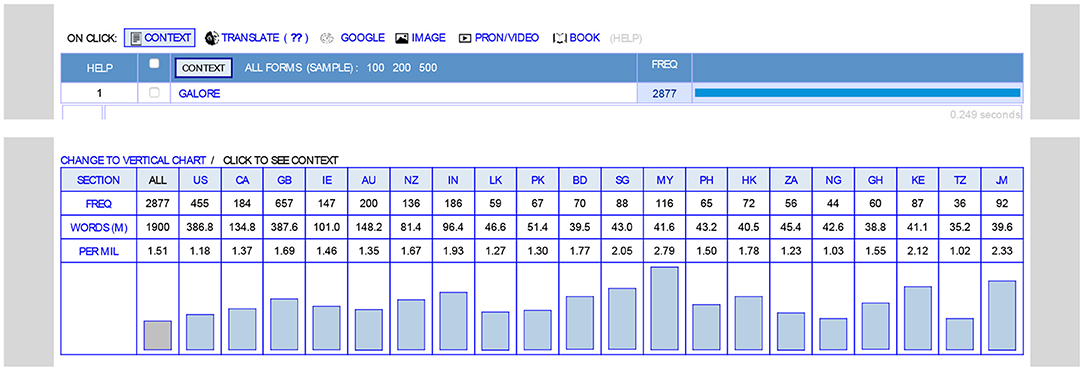
Figure 11. Distribution of galore in the GloWbE Corpus (from https://www.english-corpora.org/glowbe/).
The worldwide spread of galore shown by of the GloWbE distribution confirms the DHE claim that “this is one of the few words of Irish origin that have made their way into SE usage” (p. 109) particularly as a predicate adjective. In fact, the Irish frequency of 1.46 pmw is below the word's global average of 1.51 pmw, with a highest scores of 2.79 pmw in Malaysia and 2.33 in Jamaica. Here is an example from Northern Ireland:
He has got cups galore, that man up there (NITCS Text 20, Doagh Co. Antrim) (cups referring to trophies won as prizes).15
Of all the words which Ireland has given the world, brogue/brogues must rank as a strong candidate. According to DHE, brogue (singular) refers to “the Irish way of speaking English” and, according to Murphy (1943), originated as an English word to describe an Irish accent, being first recorded in the early 16th century with reference to a parrot which could imitate accents including Irish English (Hickey, 2007, p. 7). Nowdays, its meaning has been generalized to refer to the whole way Irish people are perceived to speak English “unintelligibly (as a result of contamination from Irish syntax and vocabulary)” (DHE).16
In Figure 12, the GloWbE map shows how widespread brogue and brogues are, but not surprisingly that most occurrences remain in Ireland.
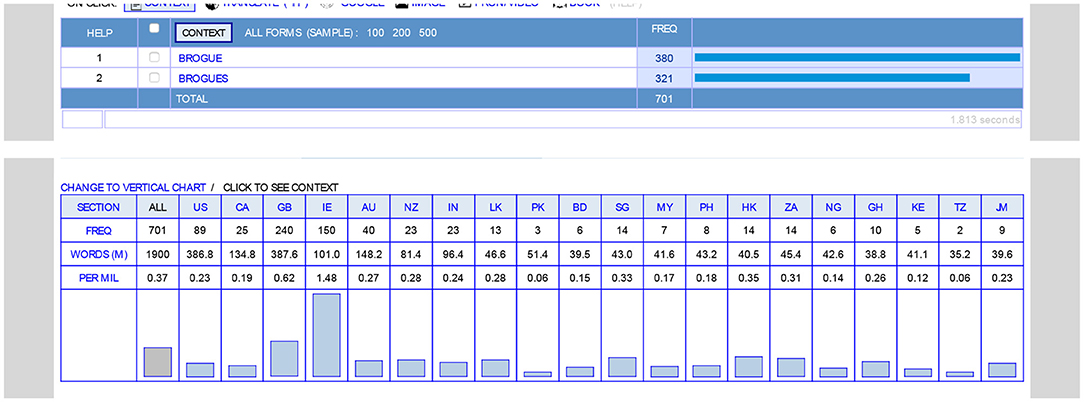
Figure 12. Distribution of brogues in the GloWbE Corpus (from https://www.english-corpora.org/glowbe/).
Another word claimed to have been given to the English language from Ireland is the noun slew, meaning “a large number or amount of something” < Irish slua “a crowd, a host, a multitude” (DHE) notwithstanding the OED: “originally U.S.”
In Figure 13, the GloWbE map shows a widespread distribution, with Ireland (with a pmw of 1.40) far from predominating compared with Jamaica (pmw 6.44), India (pmw 3.53) and the USA (pmw 3.39).

Figure 13. Distribution of slew in the GloWbE Corpus (from https://www.english-corpora.org/glowbe/).
The word slogan in English is claimed as often to come from Scottish Gaelic as it is from Irish. Originally it meant “a war cry”, from the Irish slua-ghairm or Scottish Gaelic Gaelic sluagh-ghairm “a battle cry”. However, it is its metaphoric sense of “a distinctive word or phrase used by a political or other group”, first attested 1,704, according to Etymonline, which has gone round the world, as the map in Figure 14 shows.

Figure 14. Distribution of slogan in the GloWbE Corpus (from https://www.english-corpora.org/glowbe/).
Slogan would appear now to be most frequent in Ghana (pmw 12.67) and Malaysia (pmw 10.76), compared with a pmw of 5.12 in Ireland.
The final word for consideration as an Irish contribution to English is whiskey/whiskeys, from Irish uisce “water” + beatha “life”, whence eau de vie, itself probably a loan-translation of Medieval Latin aqua vitae. In Scotland, the word is spelled whisky, which came through Scottish Gaelic from Irish as well.
In Figure 15, the GloWbE map shows not surprisingly that, although nowadays an international beverage, whiskey is most common in Ireland itself (pmw 17.68).
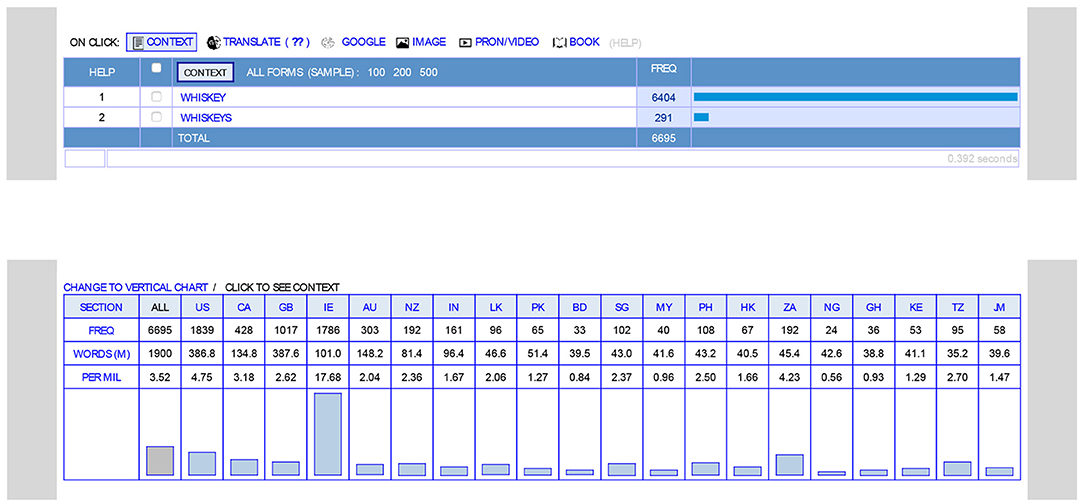
Figure 15. Distribution of whiskey/whiskeys in the GloWbE Corpus (from https://www.english-corpora.org/glowbe/).
As for the Irishisms that are favorites and much-loved at home, GloWbE can reinforce such local preferences by showing (as in Figure 16) that a word such as langers, which refers to the male penis and by extension to “a stupid or contemptible person” or to “someone who is drunk”, and which is regarded as a slang term of contempt and abuse, occurs almost exclusively in Ireland and is non-existent in many countries.
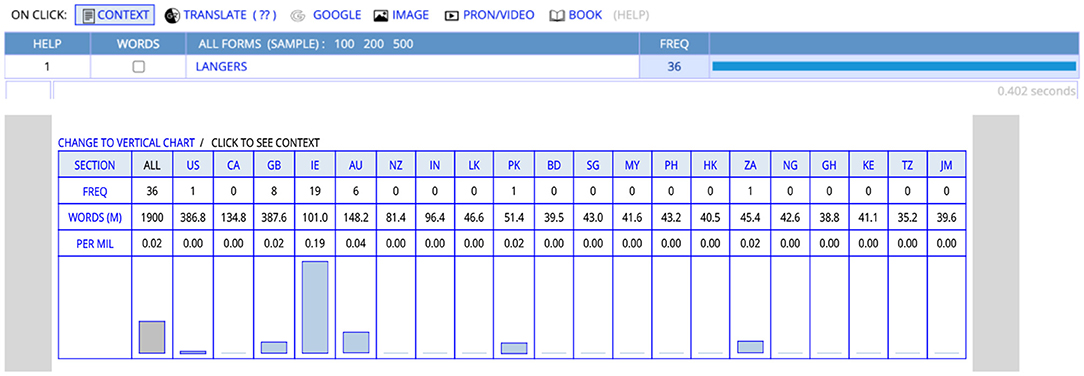
Figure 16. Distribution of langers in the GloWbE Corpus (from https://www.english-corpora.org/glowbe/).
A further favorite is Leprechaun. Few folk motifs are more indexical of the Irish than leprechauns. According to DHE, a leprechaun is “a dwarflike sprite; an industrious fairy seen at dusk or in the moonlight mending a shoe”.17 For Slanguage, leprachauns are “characteristic of perceived Oirish [sic] qualities” [i.e., “excessive or exaggerated display of perceived national characteristics”, and its use is generally derogatory]. In Figure 17, the GloWbE map shows that the country of most occurrence is indeed Ireland—not unexpectedly—at pmw 2.84, but that, with the exception of Tanzania, there are occurrences of leprechaun(s) in every other of the 20 countries surveyed. After Ireland, leprechaun occurs most frequently in, perhaps surprisingly, Singapore (pmw 0.63), followed by the USA (pmw 0.48) and then GB (pmw 0.40). The word may be Irish in origin18 but the display shows that leprechaun(s) has come to be used throughout the world, albeit in small numbers.
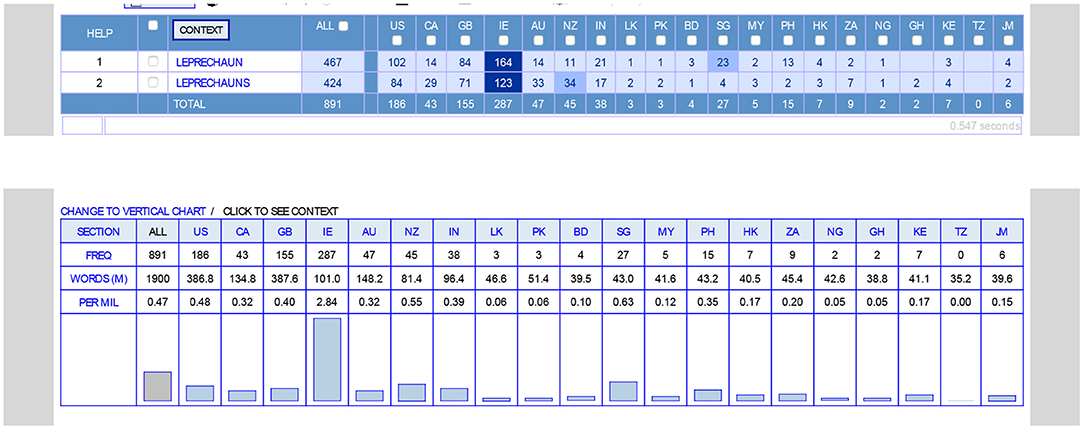
Figure 17. Distribution of leprechaun in the GloWbE Corpus (from https://www.english-corpora.org/glowbe/).
A similar distribution occurs for another indexical word of the Irish: eejit/eejits, referring to “a silly person”, “a fool”, “an idiot”, an Irish (especially Dublin) spelling pronunciation of idiot but, according to DHE, “less pejorative than StE idiot”.
In Figure 18, the GloWbE map confirms the word eejit(s) as an Irishism (pmw 2.69), with few occurrences elsewhere except for GB (pmw 0.30), where Irish influence is strongly felt.
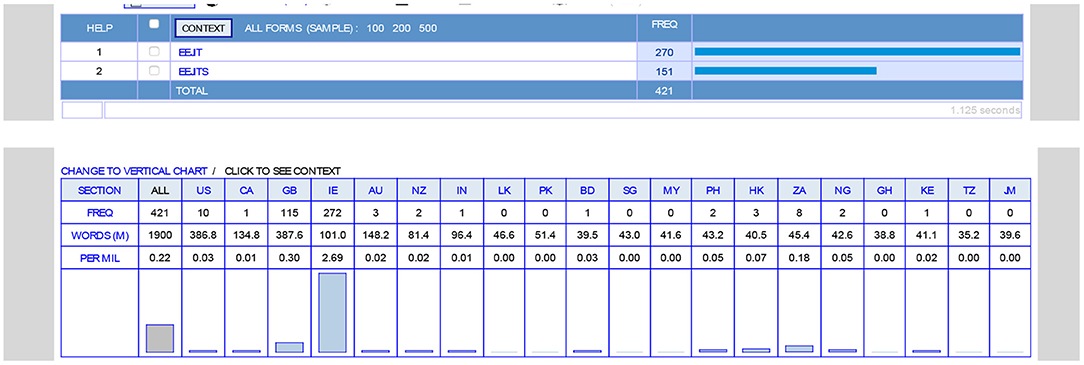
Figure 18. Distribution of eejit/eejits in the GloWbE Corpus (from https://www.english-corpora.org/glowbe/).
A further favorite word is donnybrook(s). According to DHE, donnybrook is “a riotous assembly, a free-for-all” deriving from the place-name Donnybrook, “a village near Dublin, now a respectable suburb, site of an uproarious week-long fair dating from at least the 13th century, discontinued in the middle of the 19th century”. In Figure 19, the GloWbE map shows that donnybrook(s) hardly occurs outside of Ireland at all—hardly surprising, perhaps, because of its cultural associations—and thus confirming it as another Irishism.
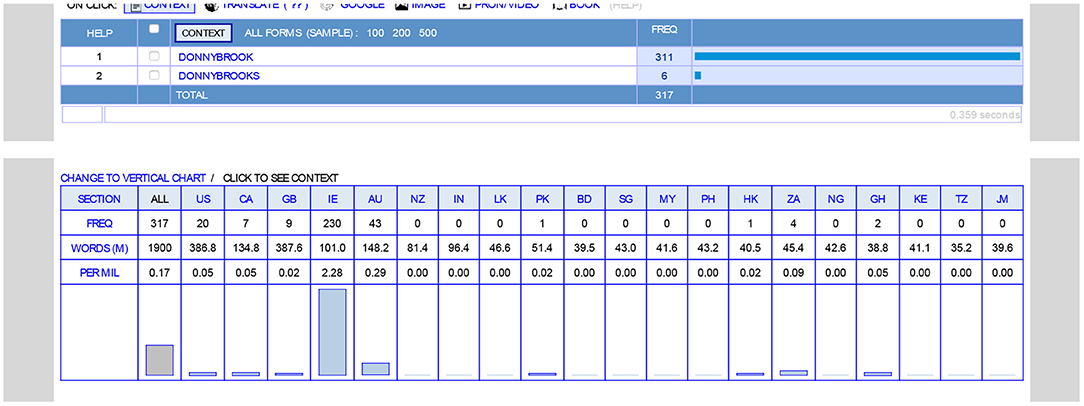
Figure 19. Distribution of donnybrook in the GloWbE Corpus (from https://www.english-corpora.org/glowbe/).
The word Tory (plural Tories), originally meaning “a bandit” or “outlaw”, “an Irish vagabond robber or rapparee” (according to Slanguage), came to acquire political connotations to refer to “an advocate for absolute monarchy and church power”. Despite its Irish origins, the concept of a Tory has nowadays narrowed and relates predominantly to members of the Conservative Party in Great Britain or in Canada. Little surprise that this word has become a culturalism which is shown, in Figure 20, on the GloWbE map to predominate in Canada (pmw 16.61) and especially in GB (pmw 77.94) but is relatively scarce elsewhere, including Ireland (pmw 7.67).
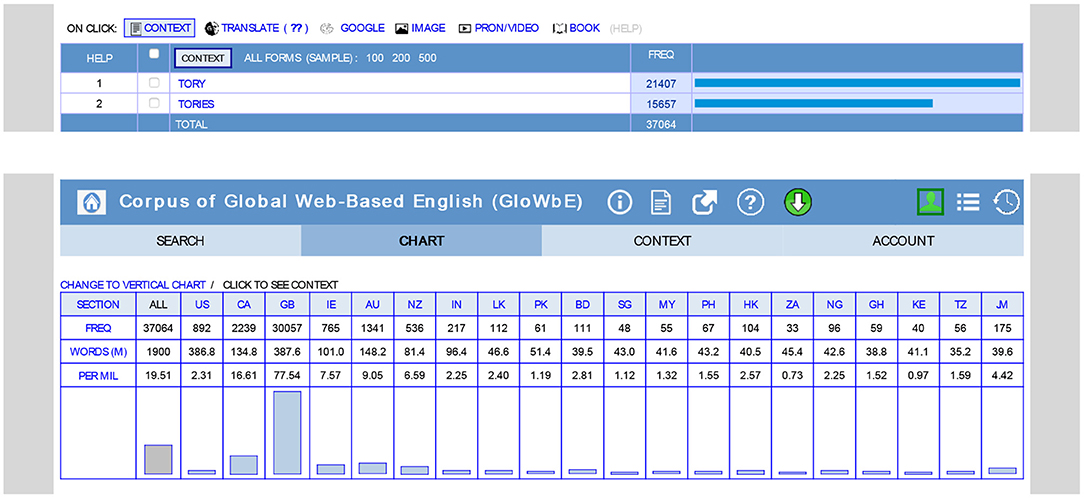
Figure 20. Distribution of Tory/Tories in the GloWbE Corpus (from https://www.english-corpora.org/glowbe/).
The final candidate for a favorite Irish word is boycott(s), meaning “refusal to cooperate”, “to exclude from all social or commercial intercourse”.19
In Figure 21, the GloWbE map shows that boycott occurs throughout the world, most frequently in Sri Lanka (pmw 13.70) and Pakistan (pmw 11.27). It has also been borrowed into German as der Boykott, for instance. Despite its source, the word can hardly be claimed to be an Irishism any more, something which could not have been predicted without such comparable corpus resources.
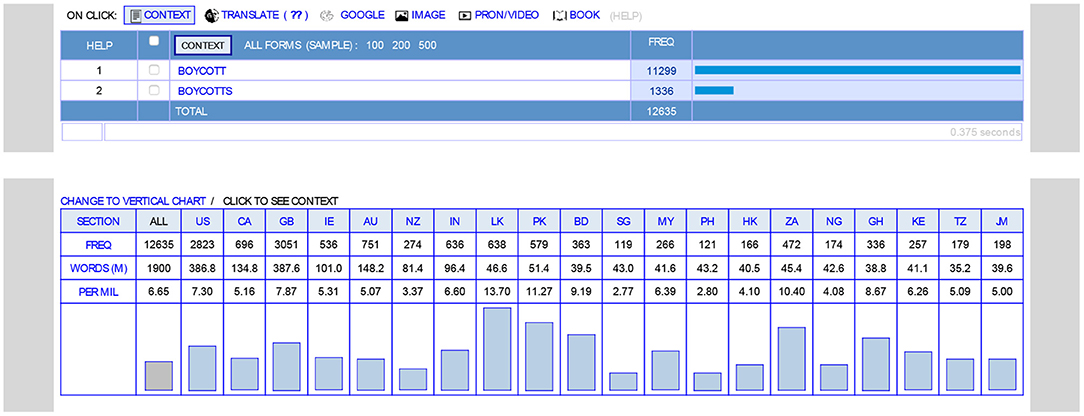
Figure 21. Distribution of boycott(s) in the GloWbE Corpus (from https://www.english-corpora.org/glowbe/).
Thus the claims about language based on common knowledge and regularly made by journalists such as Mullally and Phelan may now be verified by using resources such as GloWbE. Using GloWbE's extensive, suitably marked-up data as well as its instantaneous search and display capabilities, we have been able to show how some words are confirmed—visually confirmed on the display maps—as Irishisms whereas others which have originated in Ireland are nowadays to be found throughout the English-speaking world.
As we have seen above with the Mouton Atlas and eWAVE, attempts using morpho-syntactic data or lexical data to relate world Englishes to each other have proceeded on an item by item basis, whether the after-perfect, verb complementation patterns or lexical phenomena. Whereas there has been a focus on national varieties, when ICE corpora have been used for comparison, attention is usually paid to mode differences of distribution or function as between speech and writing, and occasionally to the various spoken discourse situations or written registers in the mode components. Registers have been variously identified on external social grounds such as the constellation of speakers or their function in communicating in the discourse situation, or whether the written texts served informational, instructional, persuasive or creative functions. Against this background, and with the availability of computational resources, there has emerged an approach of register comparison based on groupings of internal features and their implicit linguistic functions. The approach came to be known as “multi-dimensional factor analysis”, reflecting that groups of features can share the same linguistic function or “dimension”, that there are a number of key linguistic dimensions, and that consequently each dimension becomes realized through the presence of a goodly number of occurrences of each feature or, in some cases, an absence of certain other features. The method came to prominence by Biber (1988) ground-breaking study of 1988; now, after revisions by Biber himself, there is the further ground-breaking study by Bohmann (2020). Bohmann's approach has culminated in 10 dimensions (such as “involved vs. informational production” or “collaborative communicative orientation” or “conceptual vs. concrete informational focus” and so on) (p. 94–99) each indexical with a selection from some 236 linguistic forms including morpho-syntactic forms and affixes of word-formation (“the factors”) (p. 73–81). These factors have been annotated by Bohmann in respect of their respective dimensions in some ten ICE-corpora, including ICE-Ireland. Using multi-dimensional factor analysis, with regard to the distribution of scores for the dimension of “involved vs. informational production”, Bohmann observes that the scores reveal differences of style and comments that “distinctly low average values mean[…] a very clear interpersonal and structurally simple style, [which] can be noted for Canadian English, Irish English and New Zealand English, whereas the highest values are found for Indian English, Philippine English, and to a lesser extent Jamaican English and Hong Kong English.” (p. 109) Bohmann continues: ”This grouping [which Bohmann depicts in his Figure 5.3, p. 109, reproduced here as Figure 22] suggests a slight distinction between Inner and Outer Circle varieties in terms of the “involved vs. informational production” such that the former tends to be more interpersonal and structurally simpler than the latter in oral communication” (p. 109).
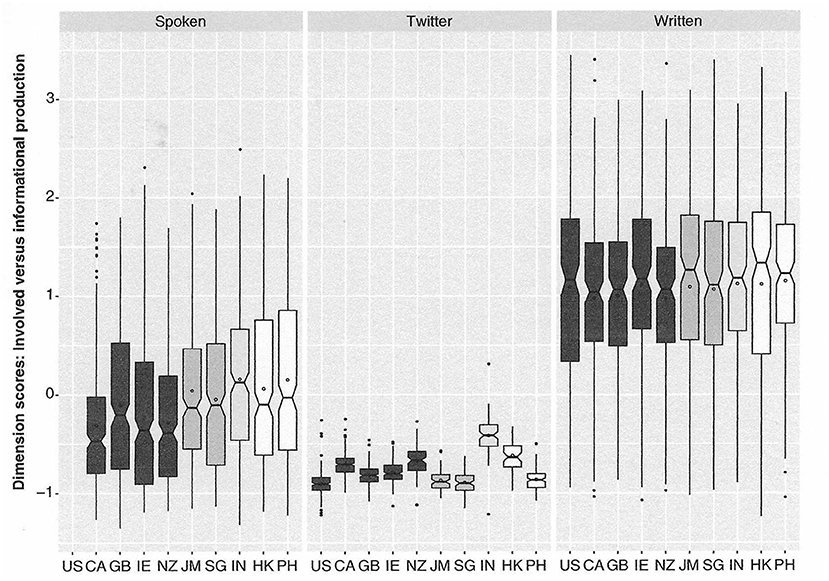
Figure 22. Bohmann's “Distribution of dimension scores across varieties and modalities; INVOLVED VS. INFORMATIONAL PRODUCTION” (from Bohmann, 2020, p. 109).
In such ways, Bohmann is able to demonstrate connections between the relationships within the Kachru model, on the one hand, and the evidence of variation between corpora on the basis of the distribution of a large amount of features on the other.
In a further investigation, ICE-corpora together with “a custom-made corpus of geolocated Twitter messages from around the English-speaking world” collected between 2011 and 2015 (known as TwICE) (Bohmann, 2020, p. 65) are compared in terms of their stage of development in the Schneider Dynamic Model. All components are at least at stage 3, with Ireland, we recall, at stage 5 (“differentiation”). Overall, Bohmann concludes that multi-dimensional factor analysis of the total data set for each country can be aligned with the theoretical insights of the Dynamic Model's evolutionary stages (p. 192). In his Figure 6.4 (p. 131), reproduced here as Figure 23, he shows that Irish English clusters with the other L1 varieties, thereby justifying its categorization as a stage-5 differentiated and L1 variety.
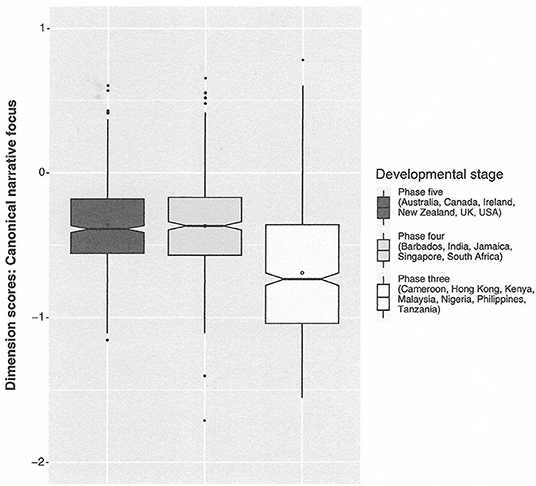
Figure 23. Bohmann's “Distributions of dimension scores for countries in different phases according to the Dynamic Model: ICE data only: CANONICAL NARRATIVE FOCUS” (from Bohmann, 2020, p. 131).
Last but not least, to identify characteristics which varieties of English have in common, let us now to turn to the most abstract level of theoretical syntactic argumentation, linguistic universals.20 A typology of seven universals is presented by Szmrecsanyi and Röthlisberger (2020, p. 542):
• GENUINE UNIVERSALS (e.g., “all languages have vowels”),
• TYPOVERSALS (“features common to languages of a specific typological type”),
• PHYLOVERSALS (“features shared by a family of genetically-related languages”),
• AEROVERSALS (“features common to languages which are in geographical proximity to each other”),
• VERNACULAR UNIVERSALS (“features that are common to spoken vernaculars”),
• ANGLOVERSALS (“features that recur in vernacular varieties” of, in this case, English),
• VARIOVERSALS (“features recurrent in language varieties with a similar socio-history, historical depth, and mode of acquisition”).
Based on the author's knowledge and observation, features of Irish English may be accounted for in several of these typologies. For starters, universally, it has vowels. Typoversally, it is basically a SVO language, although the medial-object perfect construction is an SOV construction (cf. Filppula, 1999; Hickey, 2007). Phyloversally, the extended temporal reference in uses of the past tense and present tense relates it to other Germanic languages (cf. Siemund, 2004). Aeroversally, some features which have transferred from Irish are found in Highland English, having transferred from Scottish Gaelic (cf. Sabban, 1981). Vernacularly, Irish English shares the features postulated by Jack Chambers (2004) such as double/multiple negation (usually used emphatically), angloversally (e.g., unmarked use of adjectives as adverbs) (cf. Szmrecsanyi and Kortmann, 2009), and varioversally (as in the leveling of past tense and past participle verb forms or object pronouns used as subjects) (cf. Mouton Atlas/eWAVE).
Using the data that was published in the earlier version of the Mouton Atlas and eWAVE, namely the Handbook of Varieties of English (HVE) (Kortmann et al., 2004), Szmrecsanyi and his collaborators reach similar conclusions to Bohmann. Szmrecsanyi and Röthlisberger (2020) present a multiple correspondence analysis for world Englishes. The dialectometric technique used by them is a multiple correspondence analysis, which explores how features are associated with each other in order to establish the extent to which the varieties relate to each other. Thus, had it been plotted in their Figure 23.3 (p. 545), reproduced here as Figure 24, Irish English would almost certainly have appeared in the same lower right-hand quadrant of the plot as dialects of British English with features such as the for-to infinitive and absences of deleted be. As Szmrecsanyi and Röthlisberger (2020, p. 545) comment: “the most important dimension of variation (Dim 1) pits native varieties (right) against pidgin/creoles and L2 varieties (left). The vertical dimension (Dim 2) appears to be capturing a language-externally defined contrast between orientation toward North American English (top) vs. orientation toward British English (bottom).”
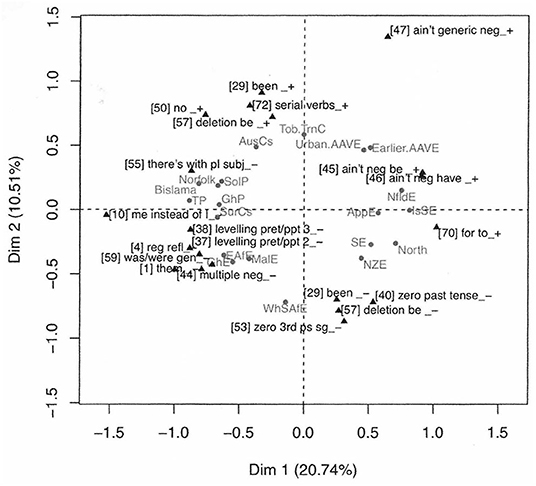
Figure 24. Szmrecsanyi and Röthlisberger's multiple correspondence analysis for world Englishes (from Szmrecsanyi and Röthlisberger, 2020, p. 545).
A further concern of Szmrecsanyi and Röthlisberger (2020) is a variety's degree of analyticity and syntheticity, which they measure as an index of free vs. bound grammatical markers per word, across a geographically widespread range of varieties of English. It appears that L2 varieties have a greater frequency of analyticity markers whereas traditional L1 varieties such as Irish English have a greater degree of syntheticity. A plot of analyticity/syntheticity (their Figure 23.4, p. 548, a differently calibrated version of Siegel et al. (2014): Figure 2, reproduced here as Figure 25) shows Irish English between Southwest of England dialects and Scottish Lowlands Dialects and surrounded by L1 countries—all set on the plot quite apart from the likes of Tok Pisin, Hawai”i Creole, Hong Kong English and Singaporean English.
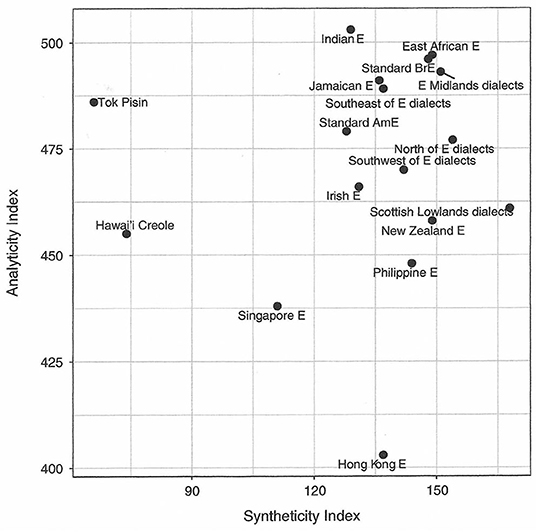
Figure 25. Szmrecsanyi and Röthlisberger's plot for syntheticity and analyticity among world Englishes (from Szmrecsanyi and Röthlisberger, 2020, p. 548; after Siegel et al., 2014; Figure 2).
A further typological dimension of comparison between varieties of world Englishes is that of complexity vs. simplicity. For many linguists all languages are equally complex. Nevertheless, some have argued that creoles are much less complex grammatically than their lexifier languages. Thus, it would appear that complexity is variable after all. The question thus arises of how complex Irish English is. Within varieties of English, it has been shown that L2 varieties are simpler—not least because of imperfect learning or the simplification of rules, or the regularization of constraints. In a nutshell, “rule simplicity predicts L2 simplicity and vice versa” (p. 551). In Szmrecsanyi and Röthlisberger (2020, p. 551), Figure 23.5, reproduced here as Figure 26, combines x-axis rule simplicity with y-axis the number of L2 simple features (what they call “acquisition simplicity”). On the basis of 76 morpho-syntactic features known to simplify in some varieties plotted against features “known to recur in interlanguage varieties” (p. 551), two points emerge in the plot: “rule simplicity predicts L2 simplicity”; and that with fewer simplyfing and simple features, L1 varieties cohere in the middle—and thus Irish English (IrE) alongside northern English dialects (North) and colloquial American English (CollAmE)—and are thus set apart from pidgins and creoles on the top periphery, with all their simplifications.
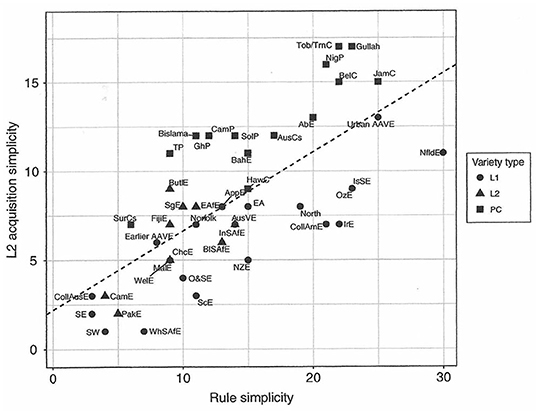
Figure 26. Szmrecsanyi and Röthlisberger's simple vs. simplifying varieties among for world Englishes (from Szmrecsanyi and Röthlisberger, 2020, p. 551).
The provision of lists of features as in the Kortmann initiatives (HVE; Mouton Atlas and eWAVE) as well as the advent of the ICE corpora have enabled previously unimagined investigations into the nature of and relationship between national varieties of world Englishes. The approaches using datasets have largely been computer-based, whether for qualitative analyses and interpretations, or for quantitative comparisons. Irish English has been at the center of all these enquiries. What emerges recurrently is confirmation of the status of Irish English as an L1 variety, however exotic the Celticity of its background might appear (cf. Kirk and Kallen, 2006). An L1 variety is, of course, a general categorical labeling which doesn't exclude the possibility of koinés (Onysko, 2016) from a contact-typological point of view, as L1 Englishes undergo further dialect contact, as shown above. Nevertheless, on the basis of increasingly global statistical analyses of the totality of the standardized data available in the ICE-Ireland corpus, the recurrence of L1 confirmation may render redundant some of the above top-down classifications of Irish English such as “sub-regional semi-standard” (Görlach, 1990), “new” (Mesthrie and Bhatt, 2008), “central” (Mair, 2013), “high contact” (eWAVE), and “differentiated” (Schneider, 2007), and “postcolonial” (Schneider, 2007). Against the results generated by multi-dimensional factor analysis or multiple correspondence analysis, such externally-motivated claims about the categorical or paradigmatic status of a national variety are difficult to substantiate on the basis of a corpus-based study.
This chapter, which explores the relationship between Irish English and world English(es), has raised many issues. It has raised the need to clarify the notion of”Irish English” recurrently, and to distinguish between the vernacular and the standardized variety, and also the need for a critical need for awareness between the two as well as for points along any postulated continuum between the two. The chapter contends that it is because of the presence of both Hiberno-English features as well as features from Scots that the wider reality of educated public discourse in Ireland is not fully standardized. It further contends that, when the status of the data is hypothesized, the substantiality of several possibilities regarding status not only within Ireland and between Ireland and Great Britain, but also between Irish and varieties of world Englishes anywhere becomes possible.
The chapter onsiders the status which has been accredited to Irish English in a number of top-down models of varieties of English around the world, by McArthur (1987); Görlach (1990); Mesthrie and Bhatt (2008); Mair (2013); Siemund (2013), and Onysko (2016), among a few others, on the one hand, and on the other by Schneider (2007) Dynamic Model. The general challenge for all models of world Englishes is their demonstration and vindication of hypotheses on the basis of empirical corpus data. Whereas there have been few attempts hitherto, the review of them by Hundt (2020) plausibly concludes that the gap would appear unbridgeable. As the present article goes on to show, there is, however, no shortage of data available—ranging from the ever-growing suite of ICE-corpora to the eWAVE database and the GloWbE corpus as resources of both non-standardized as well as standardized features, for comparison, and for statistical evaluation. A further section deals with the status of lexical items originating in Ireland and, by investigating the GloWbE corpus, is able to discriminate between those which have remained there as Irishisms and those which have spread their wings and are now to be found in almost every variety around the world. These global comparisons of individual items lead into the final part of the chapter, which is concerned with various statistical attempts to assess and relate Irish English data to a great range of varieties worldwide, including pidgins and creoles. Whether ICE-corpora are used for data or the list of observational data behind eWAVE, or whether multi-dimensional factor analysis is used on the standardized data, or whether multiple correspondence analysis is used on the reported observations of Hiberno-English data, Irish English becomes repeatedly vindicated as an L1 or (in the Schneider, 2007 model) a stage-5 differentiated, variety, tout court.
What this study also shows, in the context of national varieties of Englishes, is the difficulty of reconciling top-down, theoretical, deductive approaches with bottom-up, empirical, inductive approaches, and the need for a critical awareness and for qualification in each approach if the two are ever to meet or be reconciled. Top-down can be neat and tidy, as models of trees and circles show, but real (and especially spoken) data are messy and often unamenable to tidy categorization. It is oversimplistic to think that one unique box or circle or hypothetical category in a schema can be superimposed on a national corpus or an exclusive national dataset. For all is confluence and flux. Irish English shares many lexical and morpho-syntactic features with other varieties of world Englishes, as shown, just as it also retains many other unique lexical and morpho-syntactic features, as also shown. Some of the latter may also be relatively rare. It is seldom a case of either/or, presence or absence, if ever. The reality of patterns of features and in varying frequencies is only shown by the approaches which have become developed within corpus statistics. From the plots and graphs which emerge as the output, as exemplified above, what comes to be shown are clusters of similarities whether of features which are indicative of varieties, as Bohmann shows (Figures 22, 23), or of varieties which are indicative of the features underlying the statistics, as Szmrecsanyi and Röthlisberger show (Figures 24–26).
Nevertheless, we should not overly rely on corpus statistics as they are greatly abstracted from the original data and contexts, The popular opinion displayed in journalism can be can be corroborated by corpora—GloWbE distinguishes in lexis the global from the local or, in the case of minimal territorial expansion, the glocal, as does eWAVE for morpho-syntax. How really Irish is an Irishism can now be given a distributional answer beyond any local lexicographical treatment. National nuggets in international ore can indeed be identified and their co-existence discriminated by the research resources and tools now available. Irish English is a world English (and, despite everything, an L1 at that), but it also remains itself. Erin go bragh!
The author confirms being the sole contributor of this work and has approved it for publication.
The author declares that the research was conducted in the absence of any commercial or financial relationships that could be construed as a potential conflict of interest.
All claims expressed in this article are solely those of the authors and do not necessarily represent those of their affiliated organizations, or those of the publisher, the editors and the reviewers. Any product that may be evaluated in this article, or claim that may be made by its manufacturer, is not guaranteed or endorsed by the publisher.
I wish to acknowledge the permissions given to me to reproduce numerous figures from Cambridge University Press and one from Carl Winter Universitätsverlag. I am also grateful to Bernd Kortmann for permission to reproduce results from eWAVE, and to Mark Davies for results from GloWbE. I am greatly indebted for very constructive feedback from two reviewers as well as the editors. A shorter version of the material used in this paper, with few reproductions, has appeared in the Festschrift for Jeffrey L. Kallen as Kirk (2021).
1. ^Since those times, the interest in World Engslishes has grown exponentially, not least because of the increasing availability of ICE corpora. Publications range from handbooks (Filppula et al., 2017; Schreier et al., 2020; Kirkpatrick, 2021), numerous research monologs (Schneider, 2007; Mesthrie and Bhatt, 2008; Siemund, 2013), collections of research papers (e.g., Suárez-Gómez and Seoane, 2015; Seoane and Suárez-Gómez, 2016; Dehors, 2018; Ling Low and Pakir, 2018; De Costa et al., 2019; Buschfeld and Kautsch, 2020; Meierkord and Schneider, 2021; Onysko, 2021; Saraceni, 2021; Siemund and Leimgruber, 2021) and finally textbooks (Kirkpatrick, 2007; Siemund et al., 2012; Jenkins, 2014; Melchers et al., 2019; Lange and Leuckert, 2020; Schneider, 2020).
2. ^These 12 subtypes are “metropolitan standards”, “colonial standards”, “regional dialects”, “social dialects”, “pidgin Englishes”, “creole Englishes”, “English as a second language”, “English as a foreign language”, “immigrant Englishes”, “language-shift Englishes”, “jargon Englishes”, and “hybrid Englishes”.
3. ^For Siemund (2013), too, Irish English ranks as a shift variety as a result of contact.
4. ^Haswell (2013) presents other models of world Englishes, but as their focus is on the Asian rim, they will not be discussed further here.
5. ^All the same, Irish multi-/bi-bilingual contact almost certainly continued after the language shift with prevailing code-switching, more likely among educated members of the middle-classes.
6. ^An example of a variety clearly differentiated from British English is American English, with its own spelling variants, its many differences of morpho-syntactic variation, and especially its long-standing tradition of lexical codification, all the result of demographic and social merger and, in terms of Onysko's categorisation, “koinéisation”.
7. ^To explain the development of English toward endonormative stabilization Ronan's case is supplemented by the adoption of the Dynamic Model's sequel: the Extra- and Intra-Territorial Forces Model (Buschfeld and Kautsch, 2017), Ronan argues: “In effect, we find two colonization phases, with the second one starting in the seventeenth century, 600 years after initial settlements. Extra-territorial and intra-territorial language policies after this second settlement were considerably stricter, and the use of English, as well as the suppression of the Irish language, were enforced rigorously. Intra-territorially, the necessity to submit to the English language and culture was also stronger from the seventeenth century on than after the initial, twelfth-century settlements” (Ronan, 2020, p. 341).
8. ^As Irish English can hardly be claimed to be an epicenter, the topic won't be developed further here.
9. ^Recent online corpora such as GloWbE (with its sourcing of material solely from the Internet) or NOW (corpus of current newspaper material from the Internet) may well reflect more of Irish English's lexical distinctiveness. But see further below.
10. ^https://ewave-atlas.org (last accessed January 05, 2022). Cf. Kortmann et al. (2020).
11. ^For B, a feature “is neither pervasive nor extremely rare”; for C, a feature “exists but is extremely rare”; for D, a feature is attested as “absent” (https://ewave-atlas.org/parameters/1#2/7.1/43.4).
12. ^The other four types are “Traditional L1 varieties”, “indigenized L2 variety”, “English-based pidgins”, and “English-based creoles”.
13. ^Cf. for instance, those carried out at different times by Henry (1995) (for her 1995 book Belfast English and Standard English) or Ray Hickey (for his Survey of Irish English Usage, reported in Hickey, 2007).
14. ^https://www.english-corpora.org/glowbe/ (last accessed January 05, 2022).
15. ^The example is from the Northern Ireland Transcribed Corpus of Speech (Kirk, 2004).
16. ^By contrast, brogues (plural) refers to a pair of strong leather shoes with a pattern of holes and stitches, supposedly from Irish bróg “a shoe”, or else narrowed from Old Norse brók (“trousers”, whence breeches) (cf. Bergin, 1943, cited by Hickey, 2007, p. 7), but it is unlikely that the reference to shoes has transferred to speech to suggest that the way the Irish speak English was “as if they had a shoe on their tongue” (DHE) (clearly a false etymology!). It is only this shoe meaning which features in the entry in A History of Ireland in 100 words (Arbuthnott et al., 2019, p. 86–87).
17. ^But cf. Arbuthnott et al.. (2019, p. 117–118) for an alternative view that leprechauns are not Irish at all.
18. ^According to DHE leprechaun, is from Irish leipreachán, and accordingx to etymonline.com, leprechaun, is from Irish lupracan, a metathesis of Old Irish luchorpan, which traditionally is explained as literally “a very small body,” from lu”little, small” (from PIE root *legwh-”not heavy, having little weight”) + corpan, diminutive of corp”body,” from Latin corpus”body” (from PIE root *kwrep-”body, form, appearance”). The variant leithbragan is probably an Irish folk etymology, from leith”half” + brog “brogue” because the spirit was supposed to be always employed in making or mending a single shoe – whence the common image.
19. ^As an eponym, boycott was made famous after a certain Capt. Charles C. Boycott (1832–1897), a landowner in County Mayo, who refused to lower rents for his tenant farmers, so that his “oppressed tenants and workmen as well as local business people embarked on a celebrated policy of non-cooperation on his estate in the autumn of 1880” according to DHE.
20. ^This isn't to be confused with the notion of universals in language acquisition, as advanced by Filppula (1999); Siemund (2004), and Filppula et al. (2009), among others, as an explanation for the distinctiveness of Irish English morpho-syntax.
Anderwald, L. (2002). Negation in Non-Standard British English, Gaps, Regularizations, Asymmetries. London: Routledge.
Arbuthnott, S., Mhaonaigh, M., and Toner, G. (2019). A History of Ireland in 100 Words. Dublin: Royal Irish Academy.
Barron, A., and Schneider, K. P. (2008). Variational Pragmatics: A Focus on Regional Varieties in Pluricentric Languages. Amsterdam: John Benjamins.
Biber, D. (1988). Variation across Speech and Writing. Cambridge: Cambridge University Press. doi: 10.1017/CBO9780511621024
Bohmann, A. (2020). Variation in English Worldwide: Registers and Global Varieties. Cambridge: Cambridge University Press. doi: 10.1017/9781108751339
Buschfeld, S., and Kautsch, A. (2017). Towards an integrated approach to postcolonial and non-postcolonial englishes. World Englishes. 36, 104–126. doi: 10.1111/weng.12203
Buschfeld, S., and Kautsch, A. (2020). Modelling Worlds Englishes: A Joint Approach to Postcolonial and Non-Postcolonial Varieties. Edinburgh: Edinburgh University Press. doi: 10.3366/edinburgh/9781474445863.001.0001
Chambers, J. (2004). “Dynamic Typology and Vernacular Universals”, in Dialectology Meets Typology, ed Kortmann, B. (Berlin: Mouton de Gruyter), p. 127–145.
Corrigan, K. P. (2020). Linguistic Communities and Migratory Processes: Newcomers Acquiring Sociolinguistic Variation in Northern Ireland. Berlin: de Gruyter. doi: 10.1515/9783110614190
Crystal, D. (1995). The Cambridge Encyclopedia of the English Language. Cambridge: Cambridge University Press.
Davies, M., and Fuchs, R. (2015). Expanding horizons in the study of world englishes with the 1.9 billion word global web-based english corpus GloWbE. English World-Wide. 36, 1–28. doi: 10.1075/eww.36.1.01dav
De Costa, P. I., Crowther, D., and Maloney, J. (2019). Investigating World Englishes, Research Methodology and Practical Applications. Abingdon: Routledge. doi: 10.4324/9781315299716
Dehors, S. C. (2018). Modelling World Englishes: Assessing the Interplay of Emancipation and Globalization of ESL Varieties. Amsterdam: John Benjamins. doi: 10.1075/veaw.g61
Diskin, C., and Levey, S. (2019). Going global and sounding local: quotative variation and change in L1 and L2 speakers of Irish (Dublin) English. English World-Wide. 40, 53–78. doi: 10.1075/eww.00022.dis
Dolan, T. P. (2014). A Dictionary of Hiberno-English: The Irish Use of English. Third Edition. Dublin: Gill and Macmillan.
Edwards, A. (2016). English in the Netherlands: Forms, Functions and Attitudes. Amsterdam: John Benjamins. doi: 10.1075/veaw.g56
Filppula, M. (1999). A Grammar of Irish English: Language in Hibernian Style. London: Routledge. doi: 10.2307/29742738
Filppula, M., Klemola, J., and Paulasto, H. (2009). Vernacular Universals and Language Contacts: Evidence From Varieties of English and Beyond. Abingdon: Routledge. doi: 10.4324/9780203883426
Filppula, M., Klemola, J., and Sharma, D. (2017). The Oxford Handbook of World Englishes. Oxford: Oxford University Press,
Görlach, M. (1990). Studies in the History of the English Language. Heidelberg: Carl Winter Universitätsverlag.
Görlach, M., (ed.). (1995). “Irish English and Irish Culture in Dictionaries of English”, in More Englishes, New Studies in Varieties of English (1988–1994). (Amsterdam: John Benjamins), p. 164–191. doi: 10.1075/veaw.g13.07iri
Greenbaum, S. (1996). Comparing English Worldwide: The International Corpus of English. Oxford: Clarendon Press.
Gries, S., and Mukherjee, J. (2010). Lexical gravity across varieties of english. Int. J. Corpus Linguist. 15, 520–548. doi: 10.1075/ijcl.15.4.04gri
Haswell, C. (2013). A global model of english, how new modeling can improve the appreciation of english usage in the asia pacific region. Asia Pacific World. 4, 122–137. doi: 10.3167/apw.2013.040208
Henry, A. (1995). Belfast English and Standard English: Dialect Variation and Parametric Setting. Oxford: Oxford University Press.
Hickey, R. (2007). Irish English: History and Present-day Forms. Cambridge: Cambridge University Press.
Hundt, M. (2020). “Corpus-based approaches to world englishes,” in The Cambridge Handbook of World Englishes, eds D. Schreier, M. Hundt, and E. W. Schneider (Cambridge: Cambridge University Press), 506–533.
Jenkins, J. (2014). Global Englishes: A Resource Book for Students. Abingdon: Routledge. [Third Edition of World Englishes].
Kachru, B. B. (1982). The Other Tongue: English Across Cultures. Urbana, Ill.: University of Illinois Press.
Kallen, J. L. (1996). “Entering Lexical Fields in Irish English”, in Speech Past and Present: Studies in English Dialectology in memory of Ossi Ihalainen, eds Klemola, J., Kytö, M., and Rissanen, M. (Frankfurt am Main: Peter Lang), p. 101–129.
Kallen, J. L. (2017). “English in Ireland”, in The History of English: Varieties of English, eds Bergs, A., and Brinton, J. L. (Berlin: de Gruyter), p. 244–264.
Kallen, J. L., and Kirk, J. M. (2008). ICE-Ireland: A User's Guide. Belfast: Cló Ollscoil na Banriona.
Kirk, J. M. (2004). Northern Ireland Transcribed Corpus of Speech. Second Edition. Queen's University Belfast.
Kirk, J. M. (2021). “Irish English and World Englishes”, in Exploring the Landscapes of Irish English Research, eds Lucek, S., and Amador-Moreno, C. (Abingdon: Routledge), p. 270–288. doi: 10.4324/9781003025078-15
Kirk, J. M. (in press).“The Vocabulary of Irish English”, in Oxford Handbook of Irish English, ed Hickey, R. (Oxford: Oxford University Press).
Kirk, J. M., and Kallen, J. L. (2006). “Irish Standard English: How Celticised? How Standardised?”, in The Celtic Englishes IV: The Interface between English and the Celtic Languages, ed Tristram, H. L. C. Potsdam: (Potsdamer Universitätsverlag), p. 88–113.
Kirk, J. M., and Kallen, J. L. (2010). “How Scottish is Irish Standard English?” in Northern Lights, Northern Words: Selected Papers from the FRLSU Conference, Kirkwall 2009, Millar. Aberdeen: Forum for Research on the Languages of Scotland and Ireland. p. 178–213. Available online at: https://www.abdn.ac.uk/pfrlsu/volumes/vol2/
Kirk, J. M., and Kallen, J. L. (2011). “The Cultural Context of ICE-Ireland”, in Researching the Languages of Ireland, ed Hickey, R. (Studia Celtica Upsaliensia: Uppsala University), p. 269–290.
Kirk, J. M., and Nelson, G. (2018). The international corpus of english project: a progress report. World Englishes. 37, 697–716. doi: 10.1111/weng.12350
Kirkpatrick, A. (2007). World Englishes: Implications for International Communication and English Language Teaching. Cambridge: Cambridge University Press.
Kirkpatrick, A. (2021). The Routledge Handbook of World Englishes. Second Edition. Abingdon: Routledge. doi: 10.4324/9781003128755
Klemola, J. (1994). Periphrastic DO in south-eastern dialects of British English. Dialectologica et Geolinguistica 2, 33–51 doi: 10.1515/dig.1994.1994.2.33
Klemola, J. (2002). “Periphrastic DO: Dialectal Distribution and Origins”, in The Celtic Roots of English, Studies in Language, Vol. 37, eds. M. Filppula, J. Klemola, and H. Pitkänen (Joensuu: University of Joensuu, Faculty of Humanities), 199–210.
Kortmann, B., and Lunkenheimer, K. (2013). The Mouton World Atlas of Variation in English. Berlin: de Gruyter Mouton. doi: 10.1515/9783110280128
Kortmann, B., Lunkenheimer, K., and Ehret, K. (2020). The Electronic World Atlas of Varieties of English. Zenodo. DOI, 10).5281/zenodo.3712132. [Available online at http://ewave-atlas.org, accessed May 09, 2022]
Kortmann, B., Schneider, E., Burridge, K., Mesthrie, R., and Upton, C. (2004). A Handbook of Varieties of English. Berlin: Mouton de Gruyter.
Mair, C. (2013). The world system of englishes: accounting for the importance of mobile and mediated vernaculars. English Worldwide. 34, 253–278. doi: 10.1075/eww.34.3.01mai
Meierkord, C., and Schneider, E. (2021). World Englishes at the Grassroots. Edinburgh: Edinburgh University Press.
Mesthrie, R., and Bhatt, R. M. (2008). World Englishes, The Study of New Linguistic Varieties. Cambridge: Cambridge University Press.
Migge, B. (2012). “Irish English and recent immigrants to Ireland”, in New Perspectives on Irish English, eds Migge, B., and Ní Chiosáin, N., (Dublin: John Benjamins Publishing Company), p. 311–326. doi: 10.1075/veaw.g44.15mig
Modiano, M. (1999). International English in the global village. English Today. 15, 22–28. doi: 10.1017/S026607840001083X
Mukherjee, J., and Gries, S. (2009). Collostructional nativisation in new englishes, verb-construction associations in the international corpus of English. English World-Wide. 30, 27–51. doi: 10.1075/eww.30.1.03muk
Nestor, N., Ni Chasaide, C., and Regan, V. (2012). “Discourse “like” and social identity, A case study of Poles in Ireland”, in New Perspectives on Irish English, eds Migge, B., and Chiosáin, N. (Poland: John Benjamins Publishing company), p. 327–354. doi: 10.1075/veaw.g44.16nes
Onysko, A. (2016). Modelling world englishes from the perspective of language contact, World Englishes. 35, 196–220. doi: 10.1111/weng.12191
Quirk, R., Greenbaum, S., Leech, G., and Svartvik, J. (1985). A Comprehensive Grammar of the English Language. London: Longman.
Ronan, P. (2020). “English in Ireland, Intra-territorial Perspectives on Language Contact”, in Modelling World Englishes: A Joint Approach to Postcolonial and Non-Postcolonial Varieties, eds Buschfeld, S., and Kautsch, A. (Edinburgh: Edinburgh University Press), p. 322–346. doi: 10.3366/edinburgh/9781474445863.003.0015
Saraceni, M. (2021). Bloomsbury World Englishes, vol. 1: Paradigms, vol. 2: Ideologies, vol. 3: Pedagogies. London: Bloomsbury.
Schneider, E. (2003). The dynamics of new Englishes: from identity construction to dialect birth. Language. 79, 233–281. doi: 10.1353/lan.2003.0136
Schneider, E. (2004). How to trace structural nativization: particle verbs in world englishes. World Englishes. 23, 227–249. doi: 10.1111/j.0883-2919.2004.00348.x
Schneider, E. (2007). Postcolonial English: Varieties around the World. Cambridge: Cambridge University Press.
Schneider, E. (2014). New reflections on the evolutionary dynamics of world englishes. World Englishes. 33, 9–32. doi: 10.1111/weng.12069
Schneider, E. (2020). English Around the World: An Introduction. Second Edition. Cambridge: Cambridge University Press.
Schreier, D., Hundt, M., and Schneider, E. (2020). The Cambridge Handbook of World Englishes. Cambridge: Cambridge University Press.
Seoane, E., and Suárez-Gómez, C. (2016). World Englishes: New Theoretical and Methodological Considerations. Amsterdam: John Benjamins.
Share, B. (2014). Slanguage: A Dictionary of Slang and Colloquial English in Ireland. Third Edition. Dublin: Gill and Macmillan.
Siegel, J., Szmrecsanyi, B., and Kortmann, B. (2014). Measuring analyticity and syntheticity in creoles. J. Pidgin Creole Lang. 29, 49–85. doi: 10.1075/jpcl.29.1.02sie
Siemund, P. (2004). “Substrate, superstrate and universal: perfect constructions in Irish English”. in Dialectology Meets Typology, Kortmann, B. Berlin: Mouton de Gruyter. p. 401–434.
Siemund, P. (2013). Varieties of English: A Typological Approach. Cambridge: Cambridge University Press.
Siemund, P., Davydova, J., and Maier, G. (2012). The Amazing World of Englishes: A Practical Introduction. Berlin: de Gruyter.
Siemund, P., and Leimgruber, J. R. E. (2021). Multilingual Global Cities: Singapore, Hong Kong, Dubai. Abingdon: Routledge.
Strevens, P. (1980). Teaching English as an International Language: From Practice to Principle. Oxford: Pergamon Press.
Suárez-Gómez, C., and Seoane, E. (2015). Englishes Today: Multiple Varieties, Multiple Perspectives. Newcastle-upon-Tyne: Cambridge Scholars Publishing.
Szmrecsanyi, B., and Kortmann, B. (2009). “Vernacular universals and angloversals in a typological perspective”, in Vernacular Universals and Language Contacts: Evidence from Varieties of English and beyond, eds, Filppula, M., Klemola, J., and Paulasto, H. (London: Routledge), p. 33–53.
Szmrecsanyi, B., and Röthlisberger, M. (2020). “World Englishes from the Perspective of Dialect Typology”, in The Cambridge Handbook of World Englishes, eds Schreier, D., Hundt, M., and Schneider, E. W. (Cambridge: Cambridge University Press), p. 534–558. doi: 10.1017/9781108349406.023
Keywords: Inner and Outer Circle, dynamic model, contact, koinéisation, functionality, multi-dimensional factor analysis, universals
Citation: Kirk J (2022) Irish English as a World English. Front. Commun. 7:781320. doi: 10.3389/fcomm.2022.781320
Received: 22 September 2021; Accepted: 05 May 2022;
Published: 27 June 2022.
Edited by:
Alexander Onysko, University of Klagenfurt, AustriaReviewed by:
Nuria Edo-Marzá, University of Jaume I, SpainCopyright © 2022 Kirk. This is an open-access article distributed under the terms of the Creative Commons Attribution License (CC BY). The use, distribution or reproduction in other forums is permitted, provided the original author(s) and the copyright owner(s) are credited and that the original publication in this journal is cited, in accordance with accepted academic practice. No use, distribution or reproduction is permitted which does not comply with these terms.
*Correspondence: John Kirk, Sm9obi5raXJrQHVuaXZpZS5hYy5hdA==
Disclaimer: All claims expressed in this article are solely those of the authors and do not necessarily represent those of their affiliated organizations, or those of the publisher, the editors and the reviewers. Any product that may be evaluated in this article or claim that may be made by its manufacturer is not guaranteed or endorsed by the publisher.
Research integrity at Frontiers

Learn more about the work of our research integrity team to safeguard the quality of each article we publish.